Analysis of Digital Technologies and Innovation
VerifiedAdded on 2021/04/17
|16
|5416
|231
AI Summary
The provided document is a collection of research papers and studies related to the impact of emerging digital technologies on leadership in global business, innovation in organizations, and knowledge sharing. The assignment appears to be from a Master's or MBA program, focusing on the intersection of technology, leadership, and innovation in a global context.
Contribute Materials
Your contribution can guide someone’s learning journey. Share your
documents today.
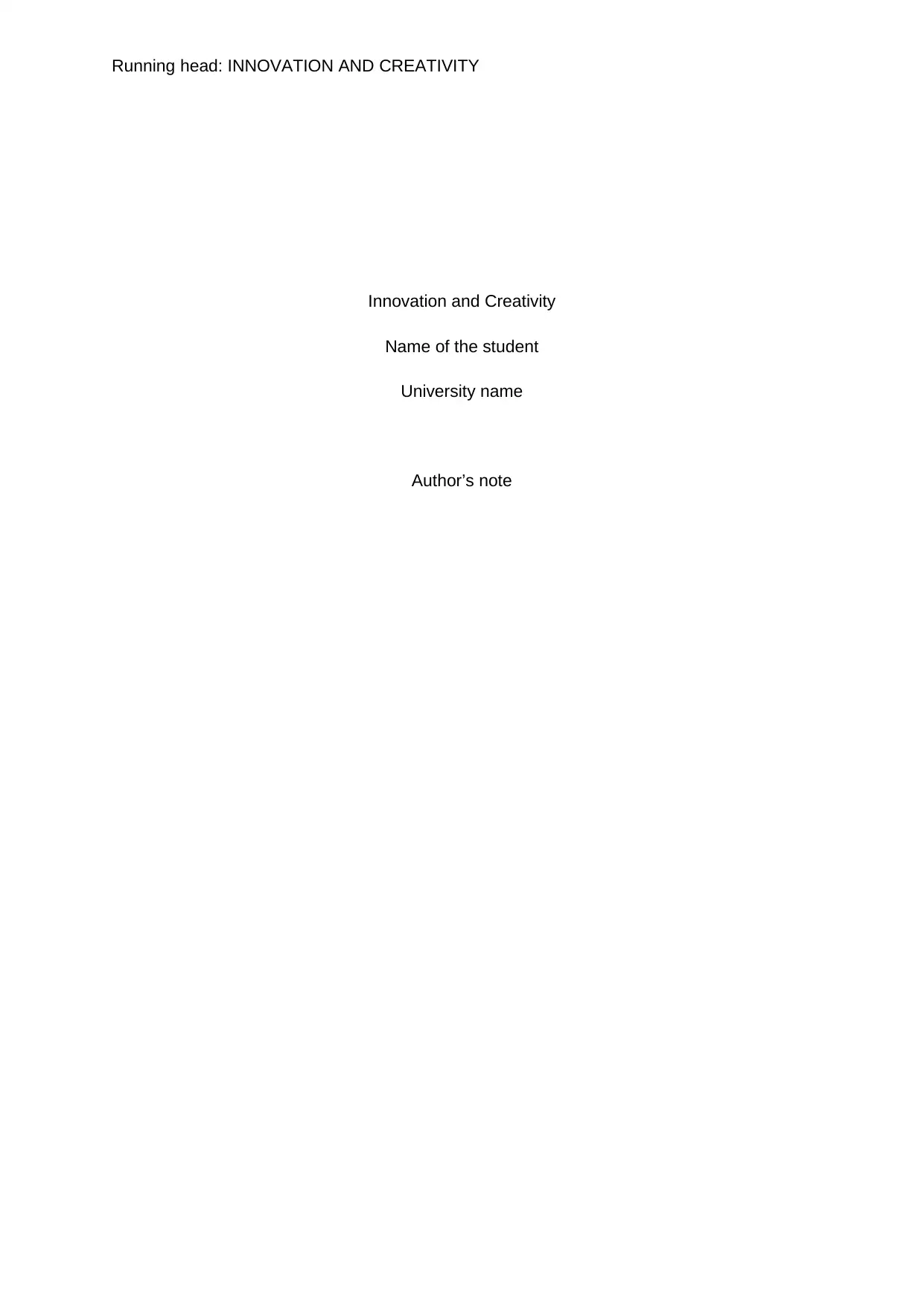
Running head: INNOVATION AND CREATIVITY
Innovation and Creativity
Name of the student
University name
Author’s note
Innovation and Creativity
Name of the student
University name
Author’s note
Secure Best Marks with AI Grader
Need help grading? Try our AI Grader for instant feedback on your assignments.
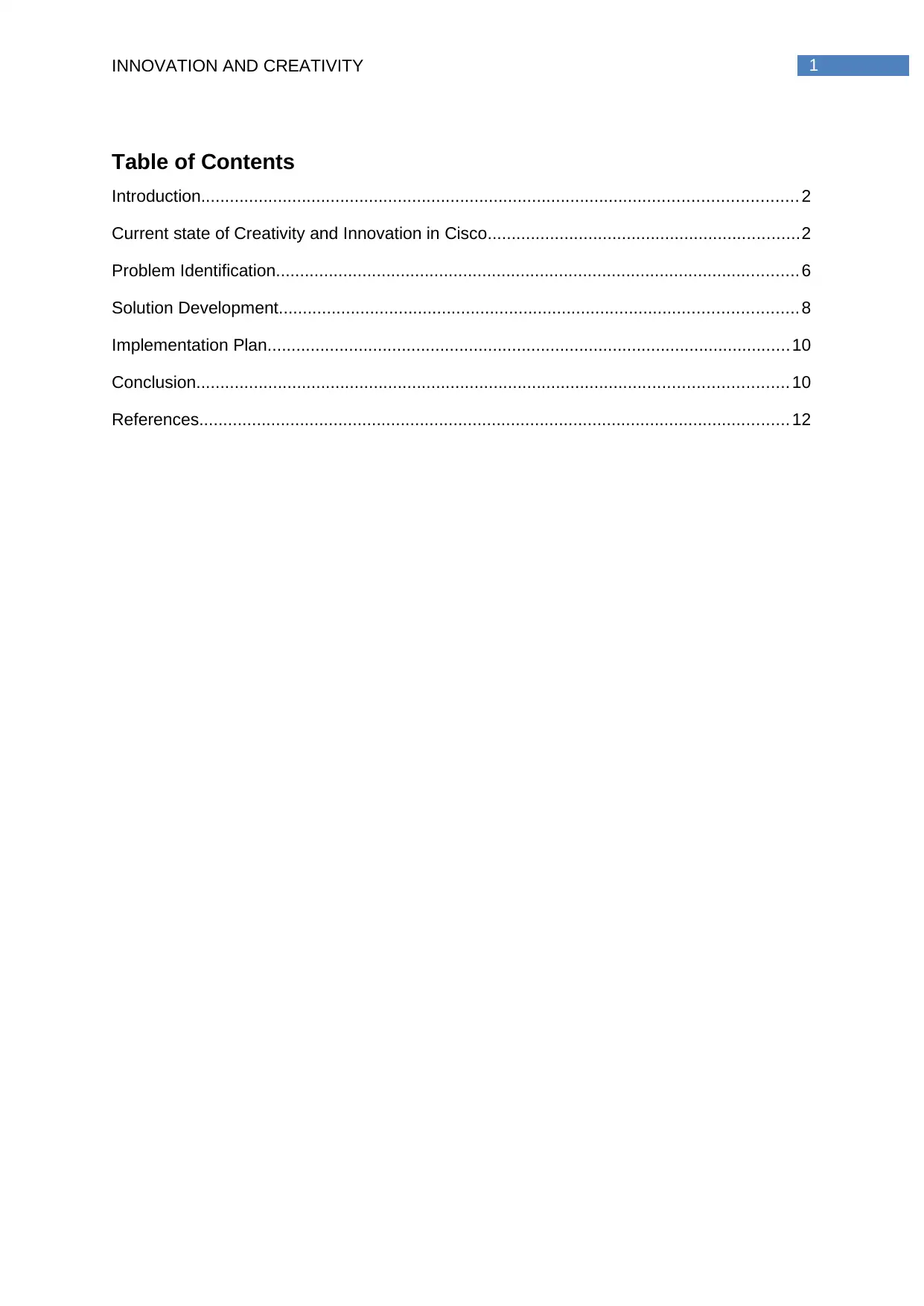
1INNOVATION AND CREATIVITY
Table of Contents
Introduction............................................................................................................................ 2
Current state of Creativity and Innovation in Cisco.................................................................2
Problem Identification............................................................................................................. 6
Solution Development............................................................................................................ 8
Implementation Plan............................................................................................................. 10
Conclusion........................................................................................................................... 10
References........................................................................................................................... 12
Table of Contents
Introduction............................................................................................................................ 2
Current state of Creativity and Innovation in Cisco.................................................................2
Problem Identification............................................................................................................. 6
Solution Development............................................................................................................ 8
Implementation Plan............................................................................................................. 10
Conclusion........................................................................................................................... 10
References........................................................................................................................... 12
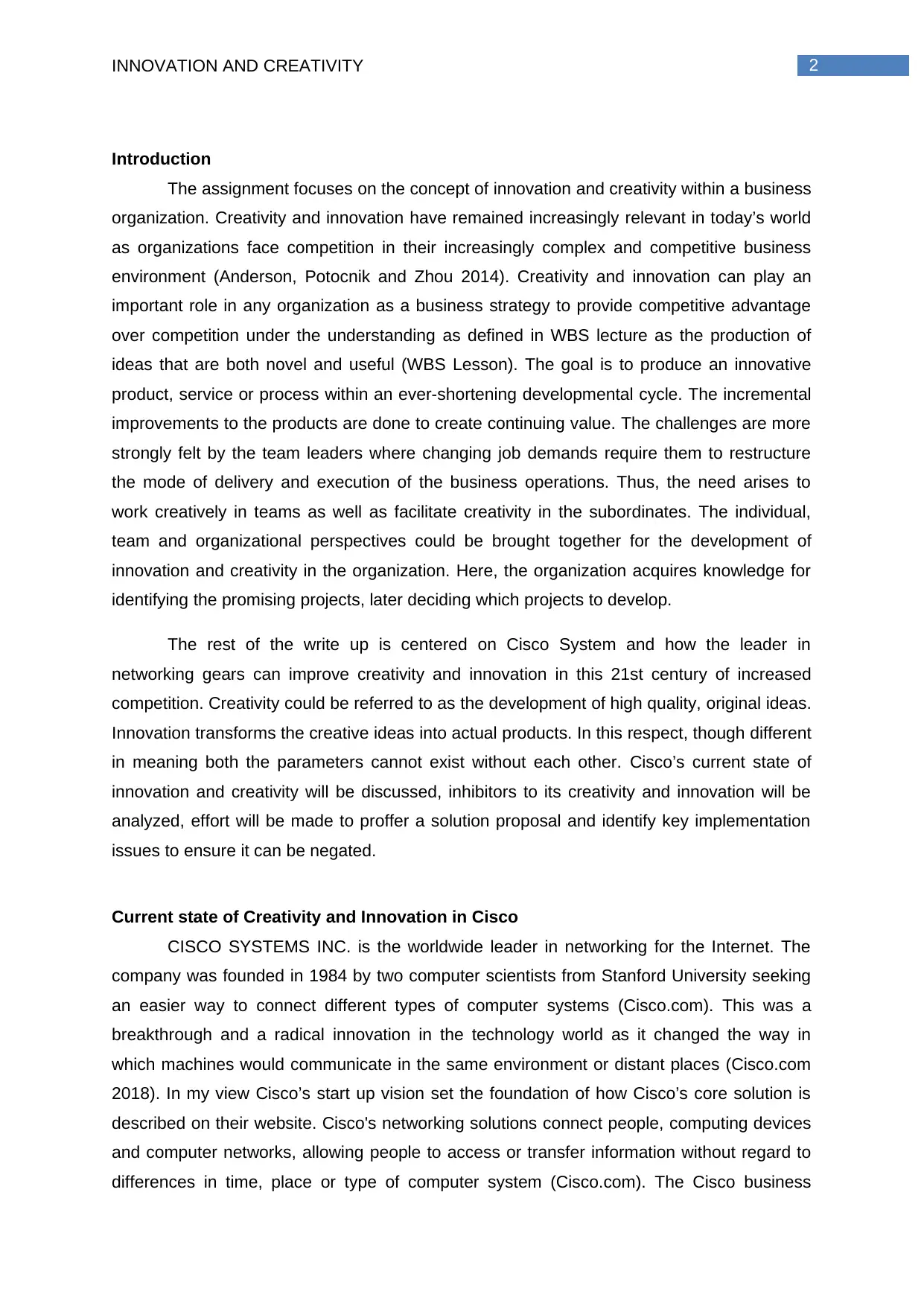
2INNOVATION AND CREATIVITY
Introduction
The assignment focuses on the concept of innovation and creativity within a business
organization. Creativity and innovation have remained increasingly relevant in today’s world
as organizations face competition in their increasingly complex and competitive business
environment (Anderson, Potocnik and Zhou 2014). Creativity and innovation can play an
important role in any organization as a business strategy to provide competitive advantage
over competition under the understanding as defined in WBS lecture as the production of
ideas that are both novel and useful (WBS Lesson). The goal is to produce an innovative
product, service or process within an ever-shortening developmental cycle. The incremental
improvements to the products are done to create continuing value. The challenges are more
strongly felt by the team leaders where changing job demands require them to restructure
the mode of delivery and execution of the business operations. Thus, the need arises to
work creatively in teams as well as facilitate creativity in the subordinates. The individual,
team and organizational perspectives could be brought together for the development of
innovation and creativity in the organization. Here, the organization acquires knowledge for
identifying the promising projects, later deciding which projects to develop.
The rest of the write up is centered on Cisco System and how the leader in
networking gears can improve creativity and innovation in this 21st century of increased
competition. Creativity could be referred to as the development of high quality, original ideas.
Innovation transforms the creative ideas into actual products. In this respect, though different
in meaning both the parameters cannot exist without each other. Cisco’s current state of
innovation and creativity will be discussed, inhibitors to its creativity and innovation will be
analyzed, effort will be made to proffer a solution proposal and identify key implementation
issues to ensure it can be negated.
Current state of Creativity and Innovation in Cisco
CISCO SYSTEMS INC. is the worldwide leader in networking for the Internet. The
company was founded in 1984 by two computer scientists from Stanford University seeking
an easier way to connect different types of computer systems (Cisco.com). This was a
breakthrough and a radical innovation in the technology world as it changed the way in
which machines would communicate in the same environment or distant places (Cisco.com
2018). In my view Cisco’s start up vision set the foundation of how Cisco’s core solution is
described on their website. Cisco's networking solutions connect people, computing devices
and computer networks, allowing people to access or transfer information without regard to
differences in time, place or type of computer system (Cisco.com). The Cisco business
Introduction
The assignment focuses on the concept of innovation and creativity within a business
organization. Creativity and innovation have remained increasingly relevant in today’s world
as organizations face competition in their increasingly complex and competitive business
environment (Anderson, Potocnik and Zhou 2014). Creativity and innovation can play an
important role in any organization as a business strategy to provide competitive advantage
over competition under the understanding as defined in WBS lecture as the production of
ideas that are both novel and useful (WBS Lesson). The goal is to produce an innovative
product, service or process within an ever-shortening developmental cycle. The incremental
improvements to the products are done to create continuing value. The challenges are more
strongly felt by the team leaders where changing job demands require them to restructure
the mode of delivery and execution of the business operations. Thus, the need arises to
work creatively in teams as well as facilitate creativity in the subordinates. The individual,
team and organizational perspectives could be brought together for the development of
innovation and creativity in the organization. Here, the organization acquires knowledge for
identifying the promising projects, later deciding which projects to develop.
The rest of the write up is centered on Cisco System and how the leader in
networking gears can improve creativity and innovation in this 21st century of increased
competition. Creativity could be referred to as the development of high quality, original ideas.
Innovation transforms the creative ideas into actual products. In this respect, though different
in meaning both the parameters cannot exist without each other. Cisco’s current state of
innovation and creativity will be discussed, inhibitors to its creativity and innovation will be
analyzed, effort will be made to proffer a solution proposal and identify key implementation
issues to ensure it can be negated.
Current state of Creativity and Innovation in Cisco
CISCO SYSTEMS INC. is the worldwide leader in networking for the Internet. The
company was founded in 1984 by two computer scientists from Stanford University seeking
an easier way to connect different types of computer systems (Cisco.com). This was a
breakthrough and a radical innovation in the technology world as it changed the way in
which machines would communicate in the same environment or distant places (Cisco.com
2018). In my view Cisco’s start up vision set the foundation of how Cisco’s core solution is
described on their website. Cisco's networking solutions connect people, computing devices
and computer networks, allowing people to access or transfer information without regard to
differences in time, place or type of computer system (Cisco.com). The Cisco business
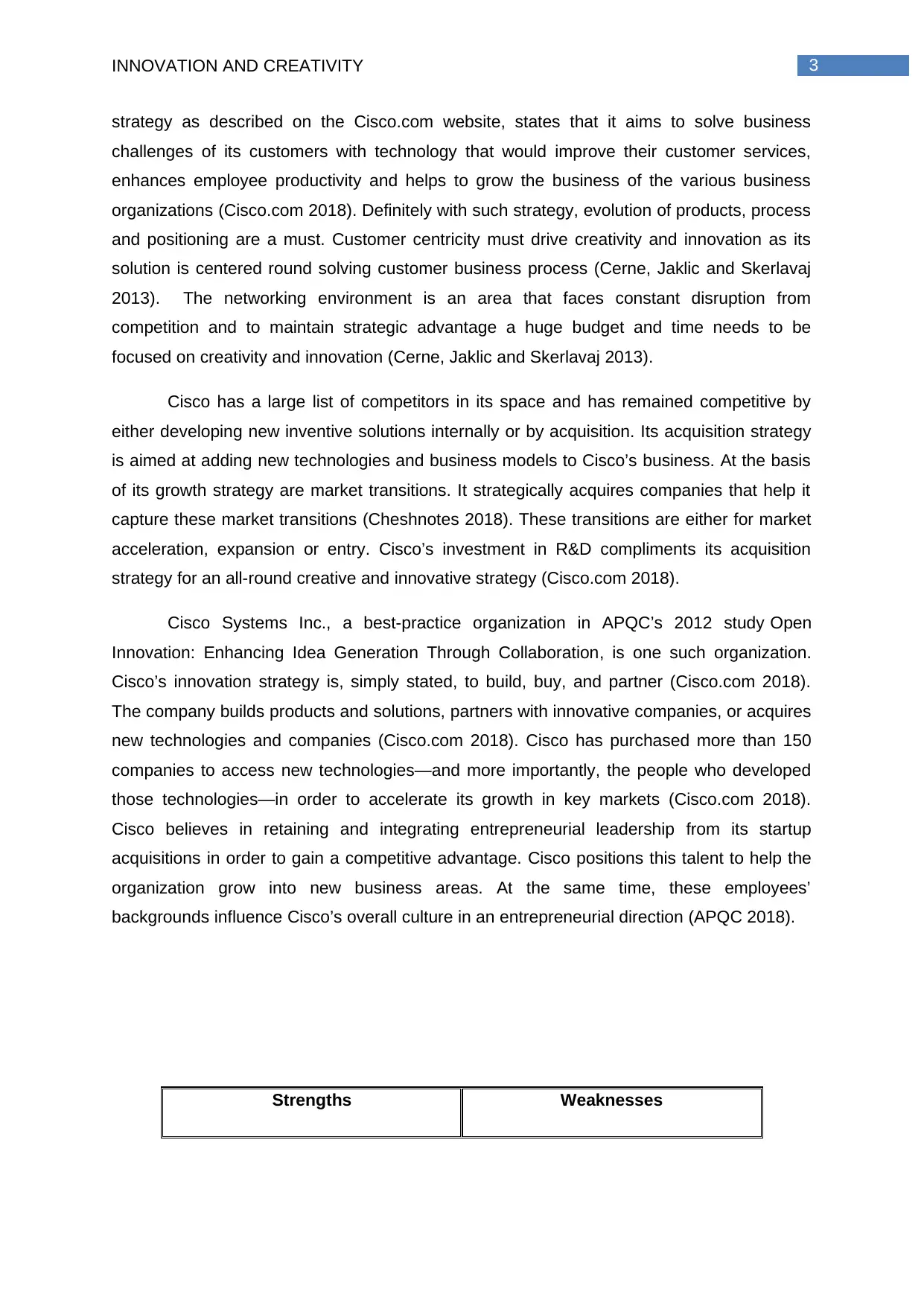
3INNOVATION AND CREATIVITY
strategy as described on the Cisco.com website, states that it aims to solve business
challenges of its customers with technology that would improve their customer services,
enhances employee productivity and helps to grow the business of the various business
organizations (Cisco.com 2018). Definitely with such strategy, evolution of products, process
and positioning are a must. Customer centricity must drive creativity and innovation as its
solution is centered round solving customer business process (Cerne, Jaklic and Skerlavaj
2013). The networking environment is an area that faces constant disruption from
competition and to maintain strategic advantage a huge budget and time needs to be
focused on creativity and innovation (Cerne, Jaklic and Skerlavaj 2013).
Cisco has a large list of competitors in its space and has remained competitive by
either developing new inventive solutions internally or by acquisition. Its acquisition strategy
is aimed at adding new technologies and business models to Cisco’s business. At the basis
of its growth strategy are market transitions. It strategically acquires companies that help it
capture these market transitions (Cheshnotes 2018). These transitions are either for market
acceleration, expansion or entry. Cisco’s investment in R&D compliments its acquisition
strategy for an all-round creative and innovative strategy (Cisco.com 2018).
Cisco Systems Inc., a best-practice organization in APQC’s 2012 study Open
Innovation: Enhancing Idea Generation Through Collaboration, is one such organization.
Cisco’s innovation strategy is, simply stated, to build, buy, and partner (Cisco.com 2018).
The company builds products and solutions, partners with innovative companies, or acquires
new technologies and companies (Cisco.com 2018). Cisco has purchased more than 150
companies to access new technologies—and more importantly, the people who developed
those technologies—in order to accelerate its growth in key markets (Cisco.com 2018).
Cisco believes in retaining and integrating entrepreneurial leadership from its startup
acquisitions in order to gain a competitive advantage. Cisco positions this talent to help the
organization grow into new business areas. At the same time, these employees’
backgrounds influence Cisco’s overall culture in an entrepreneurial direction (APQC 2018).
Strengths Weaknesses
strategy as described on the Cisco.com website, states that it aims to solve business
challenges of its customers with technology that would improve their customer services,
enhances employee productivity and helps to grow the business of the various business
organizations (Cisco.com 2018). Definitely with such strategy, evolution of products, process
and positioning are a must. Customer centricity must drive creativity and innovation as its
solution is centered round solving customer business process (Cerne, Jaklic and Skerlavaj
2013). The networking environment is an area that faces constant disruption from
competition and to maintain strategic advantage a huge budget and time needs to be
focused on creativity and innovation (Cerne, Jaklic and Skerlavaj 2013).
Cisco has a large list of competitors in its space and has remained competitive by
either developing new inventive solutions internally or by acquisition. Its acquisition strategy
is aimed at adding new technologies and business models to Cisco’s business. At the basis
of its growth strategy are market transitions. It strategically acquires companies that help it
capture these market transitions (Cheshnotes 2018). These transitions are either for market
acceleration, expansion or entry. Cisco’s investment in R&D compliments its acquisition
strategy for an all-round creative and innovative strategy (Cisco.com 2018).
Cisco Systems Inc., a best-practice organization in APQC’s 2012 study Open
Innovation: Enhancing Idea Generation Through Collaboration, is one such organization.
Cisco’s innovation strategy is, simply stated, to build, buy, and partner (Cisco.com 2018).
The company builds products and solutions, partners with innovative companies, or acquires
new technologies and companies (Cisco.com 2018). Cisco has purchased more than 150
companies to access new technologies—and more importantly, the people who developed
those technologies—in order to accelerate its growth in key markets (Cisco.com 2018).
Cisco believes in retaining and integrating entrepreneurial leadership from its startup
acquisitions in order to gain a competitive advantage. Cisco positions this talent to help the
organization grow into new business areas. At the same time, these employees’
backgrounds influence Cisco’s overall culture in an entrepreneurial direction (APQC 2018).
Strengths Weaknesses
Secure Best Marks with AI Grader
Need help grading? Try our AI Grader for instant feedback on your assignments.
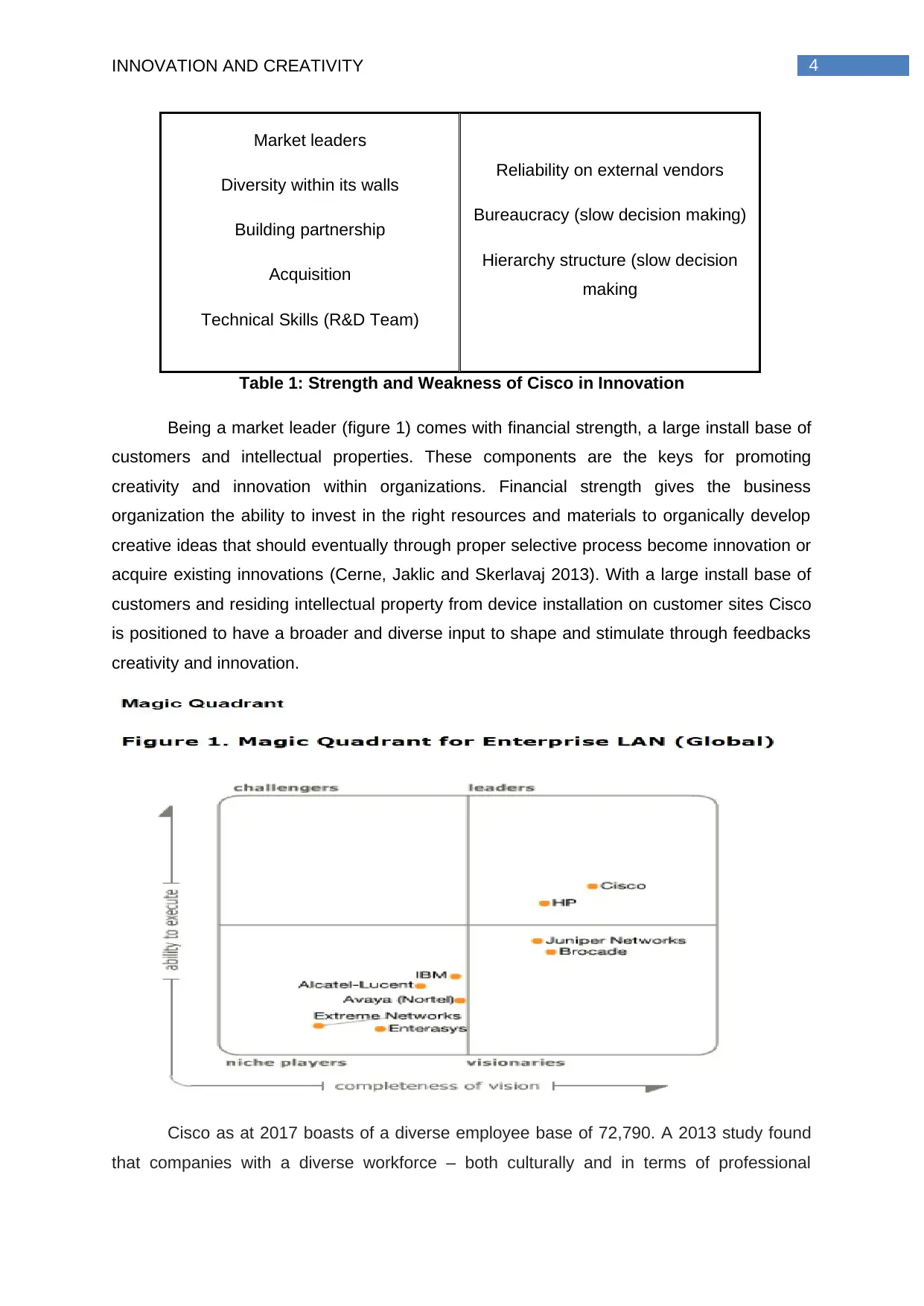
4INNOVATION AND CREATIVITY
Market leaders
Diversity within its walls
Building partnership
Acquisition
Technical Skills (R&D Team)
Reliability on external vendors
Bureaucracy (slow decision making)
Hierarchy structure (slow decision
making
Table 1: Strength and Weakness of Cisco in Innovation
Being a market leader (figure 1) comes with financial strength, a large install base of
customers and intellectual properties. These components are the keys for promoting
creativity and innovation within organizations. Financial strength gives the business
organization the ability to invest in the right resources and materials to organically develop
creative ideas that should eventually through proper selective process become innovation or
acquire existing innovations (Cerne, Jaklic and Skerlavaj 2013). With a large install base of
customers and residing intellectual property from device installation on customer sites Cisco
is positioned to have a broader and diverse input to shape and stimulate through feedbacks
creativity and innovation.
Cisco as at 2017 boasts of a diverse employee base of 72,790. A 2013 study found
that companies with a diverse workforce – both culturally and in terms of professional
Market leaders
Diversity within its walls
Building partnership
Acquisition
Technical Skills (R&D Team)
Reliability on external vendors
Bureaucracy (slow decision making)
Hierarchy structure (slow decision
making
Table 1: Strength and Weakness of Cisco in Innovation
Being a market leader (figure 1) comes with financial strength, a large install base of
customers and intellectual properties. These components are the keys for promoting
creativity and innovation within organizations. Financial strength gives the business
organization the ability to invest in the right resources and materials to organically develop
creative ideas that should eventually through proper selective process become innovation or
acquire existing innovations (Cerne, Jaklic and Skerlavaj 2013). With a large install base of
customers and residing intellectual property from device installation on customer sites Cisco
is positioned to have a broader and diverse input to shape and stimulate through feedbacks
creativity and innovation.
Cisco as at 2017 boasts of a diverse employee base of 72,790. A 2013 study found
that companies with a diverse workforce – both culturally and in terms of professional
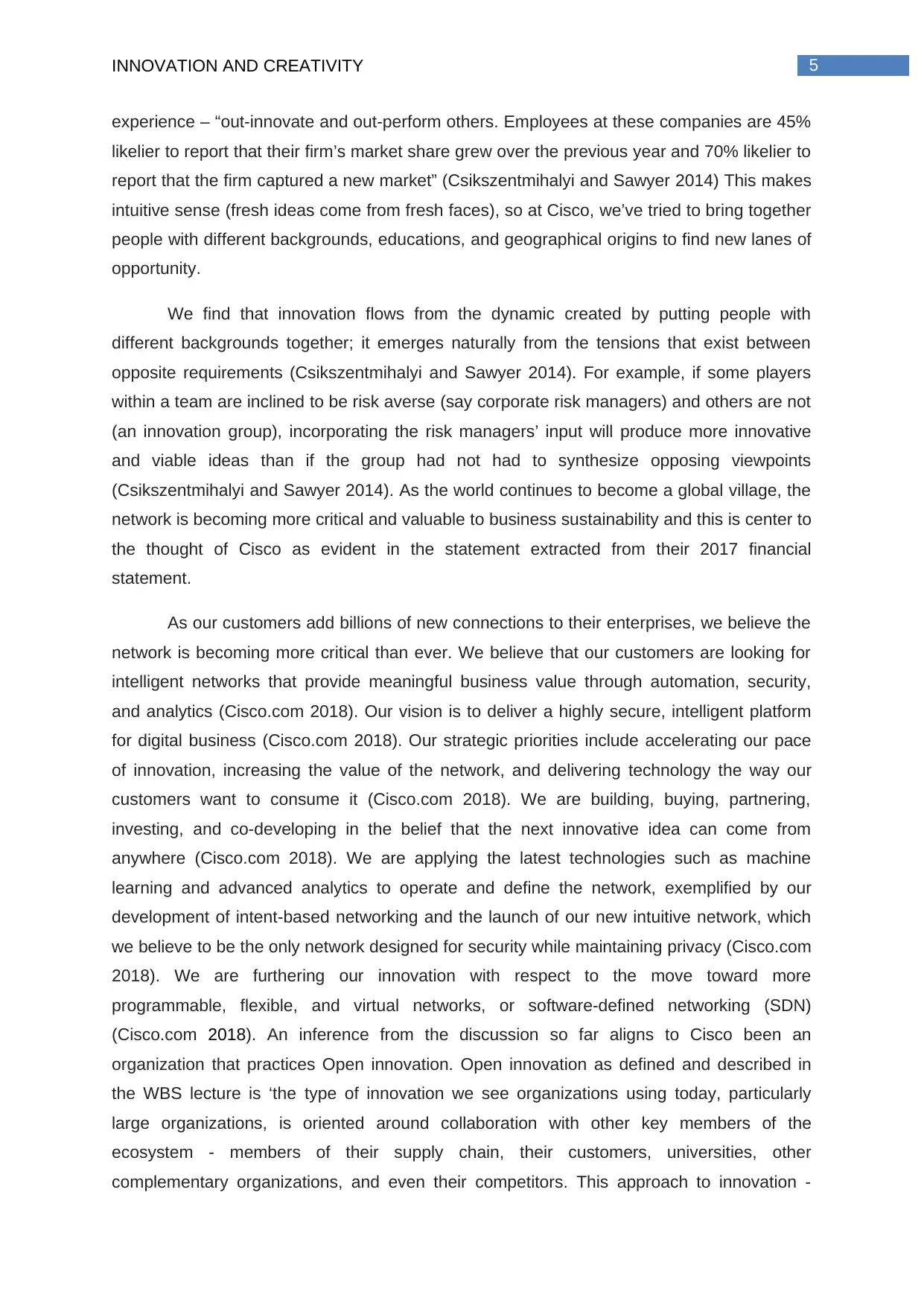
5INNOVATION AND CREATIVITY
experience – “out-innovate and out-perform others. Employees at these companies are 45%
likelier to report that their firm’s market share grew over the previous year and 70% likelier to
report that the firm captured a new market” (Csikszentmihalyi and Sawyer 2014) This makes
intuitive sense (fresh ideas come from fresh faces), so at Cisco, we’ve tried to bring together
people with different backgrounds, educations, and geographical origins to find new lanes of
opportunity.
We find that innovation flows from the dynamic created by putting people with
different backgrounds together; it emerges naturally from the tensions that exist between
opposite requirements (Csikszentmihalyi and Sawyer 2014). For example, if some players
within a team are inclined to be risk averse (say corporate risk managers) and others are not
(an innovation group), incorporating the risk managers’ input will produce more innovative
and viable ideas than if the group had not had to synthesize opposing viewpoints
(Csikszentmihalyi and Sawyer 2014). As the world continues to become a global village, the
network is becoming more critical and valuable to business sustainability and this is center to
the thought of Cisco as evident in the statement extracted from their 2017 financial
statement.
As our customers add billions of new connections to their enterprises, we believe the
network is becoming more critical than ever. We believe that our customers are looking for
intelligent networks that provide meaningful business value through automation, security,
and analytics (Cisco.com 2018). Our vision is to deliver a highly secure, intelligent platform
for digital business (Cisco.com 2018). Our strategic priorities include accelerating our pace
of innovation, increasing the value of the network, and delivering technology the way our
customers want to consume it (Cisco.com 2018). We are building, buying, partnering,
investing, and co-developing in the belief that the next innovative idea can come from
anywhere (Cisco.com 2018). We are applying the latest technologies such as machine
learning and advanced analytics to operate and define the network, exemplified by our
development of intent-based networking and the launch of our new intuitive network, which
we believe to be the only network designed for security while maintaining privacy (Cisco.com
2018). We are furthering our innovation with respect to the move toward more
programmable, flexible, and virtual networks, or software-defined networking (SDN)
(Cisco.com 2018). An inference from the discussion so far aligns to Cisco been an
organization that practices Open innovation. Open innovation as defined and described in
the WBS lecture is ‘the type of innovation we see organizations using today, particularly
large organizations, is oriented around collaboration with other key members of the
ecosystem - members of their supply chain, their customers, universities, other
complementary organizations, and even their competitors. This approach to innovation -
experience – “out-innovate and out-perform others. Employees at these companies are 45%
likelier to report that their firm’s market share grew over the previous year and 70% likelier to
report that the firm captured a new market” (Csikszentmihalyi and Sawyer 2014) This makes
intuitive sense (fresh ideas come from fresh faces), so at Cisco, we’ve tried to bring together
people with different backgrounds, educations, and geographical origins to find new lanes of
opportunity.
We find that innovation flows from the dynamic created by putting people with
different backgrounds together; it emerges naturally from the tensions that exist between
opposite requirements (Csikszentmihalyi and Sawyer 2014). For example, if some players
within a team are inclined to be risk averse (say corporate risk managers) and others are not
(an innovation group), incorporating the risk managers’ input will produce more innovative
and viable ideas than if the group had not had to synthesize opposing viewpoints
(Csikszentmihalyi and Sawyer 2014). As the world continues to become a global village, the
network is becoming more critical and valuable to business sustainability and this is center to
the thought of Cisco as evident in the statement extracted from their 2017 financial
statement.
As our customers add billions of new connections to their enterprises, we believe the
network is becoming more critical than ever. We believe that our customers are looking for
intelligent networks that provide meaningful business value through automation, security,
and analytics (Cisco.com 2018). Our vision is to deliver a highly secure, intelligent platform
for digital business (Cisco.com 2018). Our strategic priorities include accelerating our pace
of innovation, increasing the value of the network, and delivering technology the way our
customers want to consume it (Cisco.com 2018). We are building, buying, partnering,
investing, and co-developing in the belief that the next innovative idea can come from
anywhere (Cisco.com 2018). We are applying the latest technologies such as machine
learning and advanced analytics to operate and define the network, exemplified by our
development of intent-based networking and the launch of our new intuitive network, which
we believe to be the only network designed for security while maintaining privacy (Cisco.com
2018). We are furthering our innovation with respect to the move toward more
programmable, flexible, and virtual networks, or software-defined networking (SDN)
(Cisco.com 2018). An inference from the discussion so far aligns to Cisco been an
organization that practices Open innovation. Open innovation as defined and described in
the WBS lecture is ‘the type of innovation we see organizations using today, particularly
large organizations, is oriented around collaboration with other key members of the
ecosystem - members of their supply chain, their customers, universities, other
complementary organizations, and even their competitors. This approach to innovation -
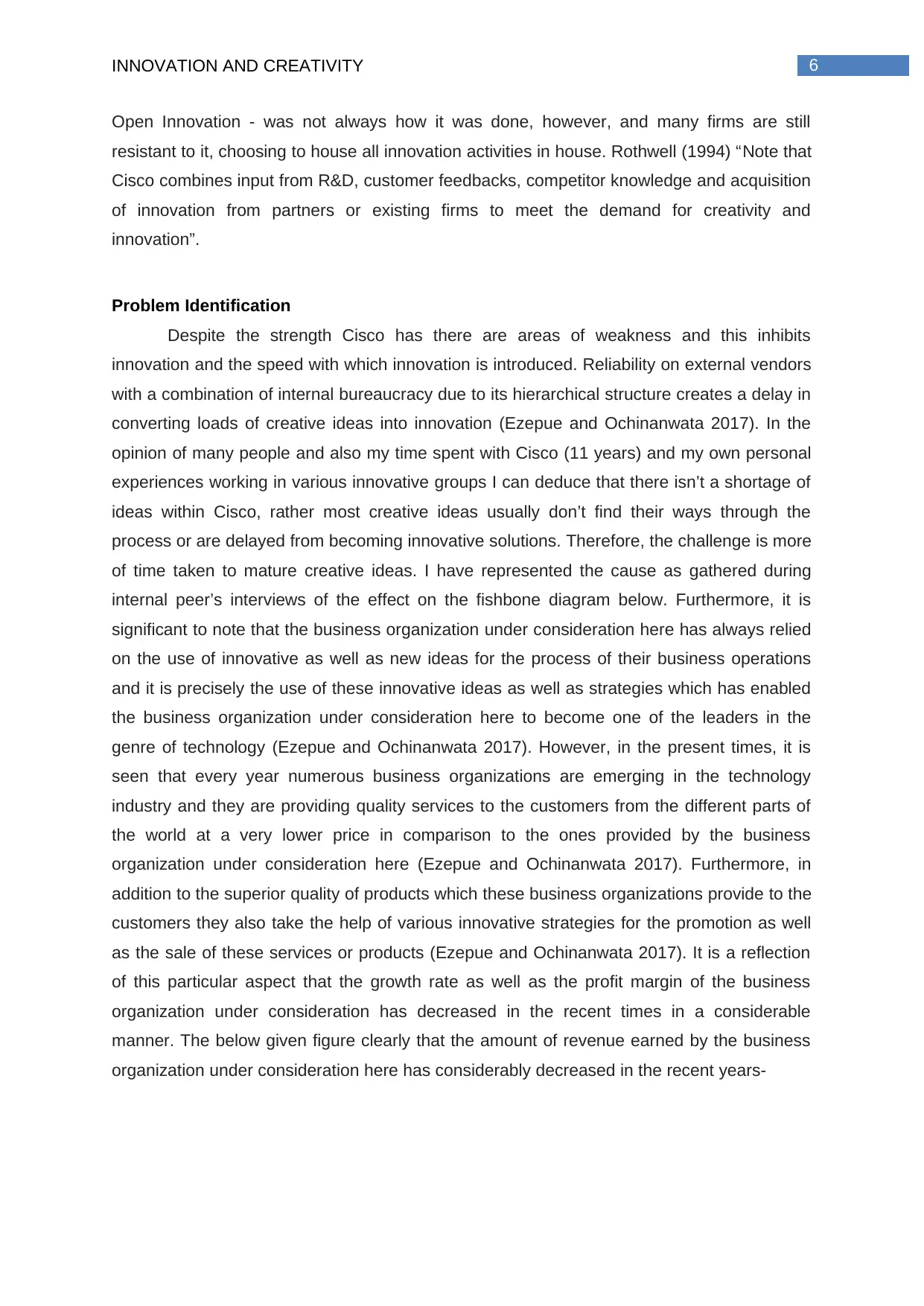
6INNOVATION AND CREATIVITY
Open Innovation - was not always how it was done, however, and many firms are still
resistant to it, choosing to house all innovation activities in house. Rothwell (1994) “Note that
Cisco combines input from R&D, customer feedbacks, competitor knowledge and acquisition
of innovation from partners or existing firms to meet the demand for creativity and
innovation”.
Problem Identification
Despite the strength Cisco has there are areas of weakness and this inhibits
innovation and the speed with which innovation is introduced. Reliability on external vendors
with a combination of internal bureaucracy due to its hierarchical structure creates a delay in
converting loads of creative ideas into innovation (Ezepue and Ochinanwata 2017). In the
opinion of many people and also my time spent with Cisco (11 years) and my own personal
experiences working in various innovative groups I can deduce that there isn’t a shortage of
ideas within Cisco, rather most creative ideas usually don’t find their ways through the
process or are delayed from becoming innovative solutions. Therefore, the challenge is more
of time taken to mature creative ideas. I have represented the cause as gathered during
internal peer’s interviews of the effect on the fishbone diagram below. Furthermore, it is
significant to note that the business organization under consideration here has always relied
on the use of innovative as well as new ideas for the process of their business operations
and it is precisely the use of these innovative ideas as well as strategies which has enabled
the business organization under consideration here to become one of the leaders in the
genre of technology (Ezepue and Ochinanwata 2017). However, in the present times, it is
seen that every year numerous business organizations are emerging in the technology
industry and they are providing quality services to the customers from the different parts of
the world at a very lower price in comparison to the ones provided by the business
organization under consideration here (Ezepue and Ochinanwata 2017). Furthermore, in
addition to the superior quality of products which these business organizations provide to the
customers they also take the help of various innovative strategies for the promotion as well
as the sale of these services or products (Ezepue and Ochinanwata 2017). It is a reflection
of this particular aspect that the growth rate as well as the profit margin of the business
organization under consideration has decreased in the recent times in a considerable
manner. The below given figure clearly that the amount of revenue earned by the business
organization under consideration here has considerably decreased in the recent years-
Open Innovation - was not always how it was done, however, and many firms are still
resistant to it, choosing to house all innovation activities in house. Rothwell (1994) “Note that
Cisco combines input from R&D, customer feedbacks, competitor knowledge and acquisition
of innovation from partners or existing firms to meet the demand for creativity and
innovation”.
Problem Identification
Despite the strength Cisco has there are areas of weakness and this inhibits
innovation and the speed with which innovation is introduced. Reliability on external vendors
with a combination of internal bureaucracy due to its hierarchical structure creates a delay in
converting loads of creative ideas into innovation (Ezepue and Ochinanwata 2017). In the
opinion of many people and also my time spent with Cisco (11 years) and my own personal
experiences working in various innovative groups I can deduce that there isn’t a shortage of
ideas within Cisco, rather most creative ideas usually don’t find their ways through the
process or are delayed from becoming innovative solutions. Therefore, the challenge is more
of time taken to mature creative ideas. I have represented the cause as gathered during
internal peer’s interviews of the effect on the fishbone diagram below. Furthermore, it is
significant to note that the business organization under consideration here has always relied
on the use of innovative as well as new ideas for the process of their business operations
and it is precisely the use of these innovative ideas as well as strategies which has enabled
the business organization under consideration here to become one of the leaders in the
genre of technology (Ezepue and Ochinanwata 2017). However, in the present times, it is
seen that every year numerous business organizations are emerging in the technology
industry and they are providing quality services to the customers from the different parts of
the world at a very lower price in comparison to the ones provided by the business
organization under consideration here (Ezepue and Ochinanwata 2017). Furthermore, in
addition to the superior quality of products which these business organizations provide to the
customers they also take the help of various innovative strategies for the promotion as well
as the sale of these services or products (Ezepue and Ochinanwata 2017). It is a reflection
of this particular aspect that the growth rate as well as the profit margin of the business
organization under consideration has decreased in the recent times in a considerable
manner. The below given figure clearly that the amount of revenue earned by the business
organization under consideration here has considerably decreased in the recent years-
Paraphrase This Document
Need a fresh take? Get an instant paraphrase of this document with our AI Paraphraser
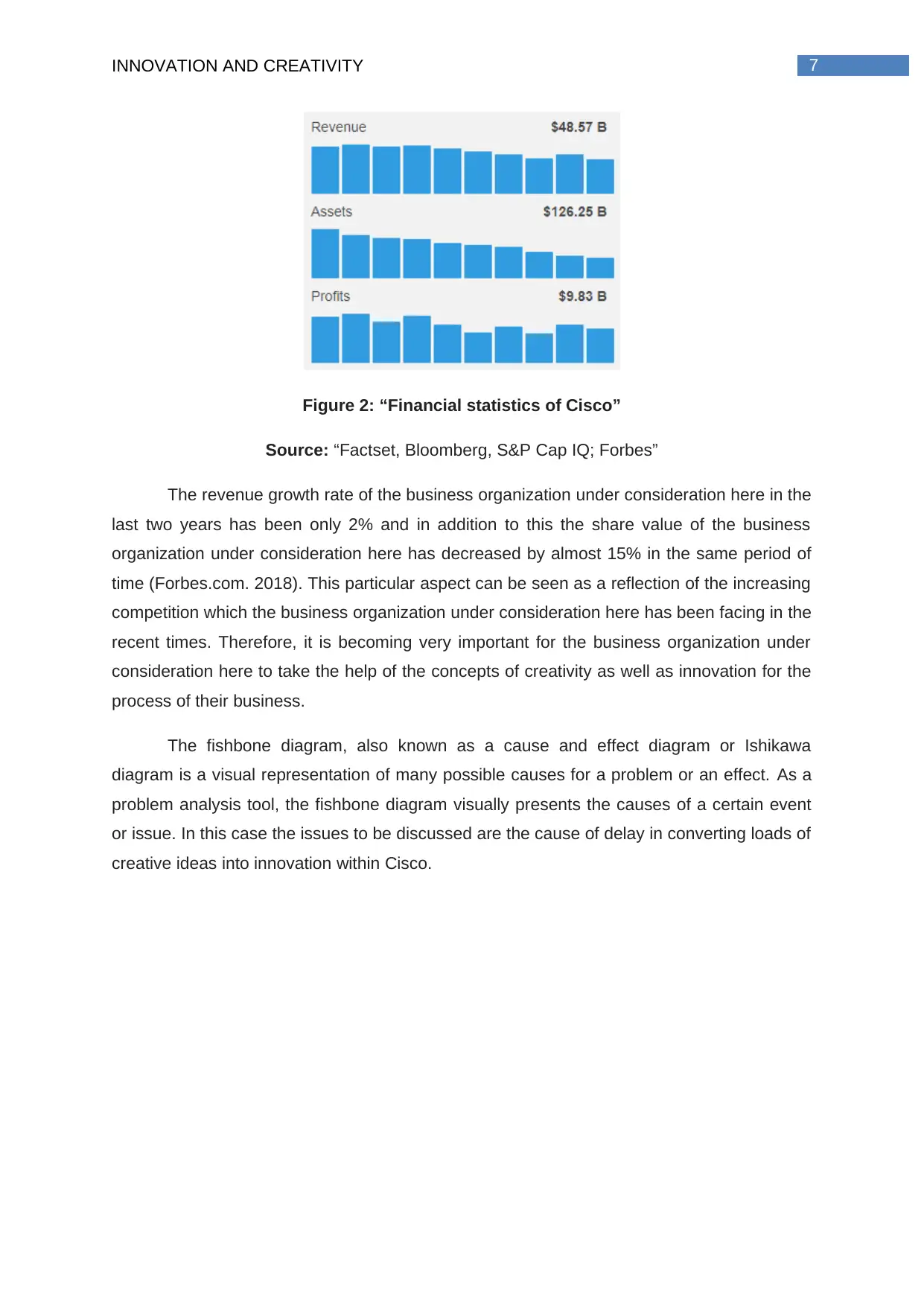
7INNOVATION AND CREATIVITY
Figure 2: “Financial statistics of Cisco”
Source: “Factset, Bloomberg, S&P Cap IQ; Forbes”
The revenue growth rate of the business organization under consideration here in the
last two years has been only 2% and in addition to this the share value of the business
organization under consideration here has decreased by almost 15% in the same period of
time (Forbes.com. 2018). This particular aspect can be seen as a reflection of the increasing
competition which the business organization under consideration here has been facing in the
recent times. Therefore, it is becoming very important for the business organization under
consideration here to take the help of the concepts of creativity as well as innovation for the
process of their business.
The fishbone diagram, also known as a cause and effect diagram or Ishikawa
diagram is a visual representation of many possible causes for a problem or an effect. As a
problem analysis tool, the fishbone diagram visually presents the causes of a certain event
or issue. In this case the issues to be discussed are the cause of delay in converting loads of
creative ideas into innovation within Cisco.
Figure 2: “Financial statistics of Cisco”
Source: “Factset, Bloomberg, S&P Cap IQ; Forbes”
The revenue growth rate of the business organization under consideration here in the
last two years has been only 2% and in addition to this the share value of the business
organization under consideration here has decreased by almost 15% in the same period of
time (Forbes.com. 2018). This particular aspect can be seen as a reflection of the increasing
competition which the business organization under consideration here has been facing in the
recent times. Therefore, it is becoming very important for the business organization under
consideration here to take the help of the concepts of creativity as well as innovation for the
process of their business.
The fishbone diagram, also known as a cause and effect diagram or Ishikawa
diagram is a visual representation of many possible causes for a problem or an effect. As a
problem analysis tool, the fishbone diagram visually presents the causes of a certain event
or issue. In this case the issues to be discussed are the cause of delay in converting loads of
creative ideas into innovation within Cisco.
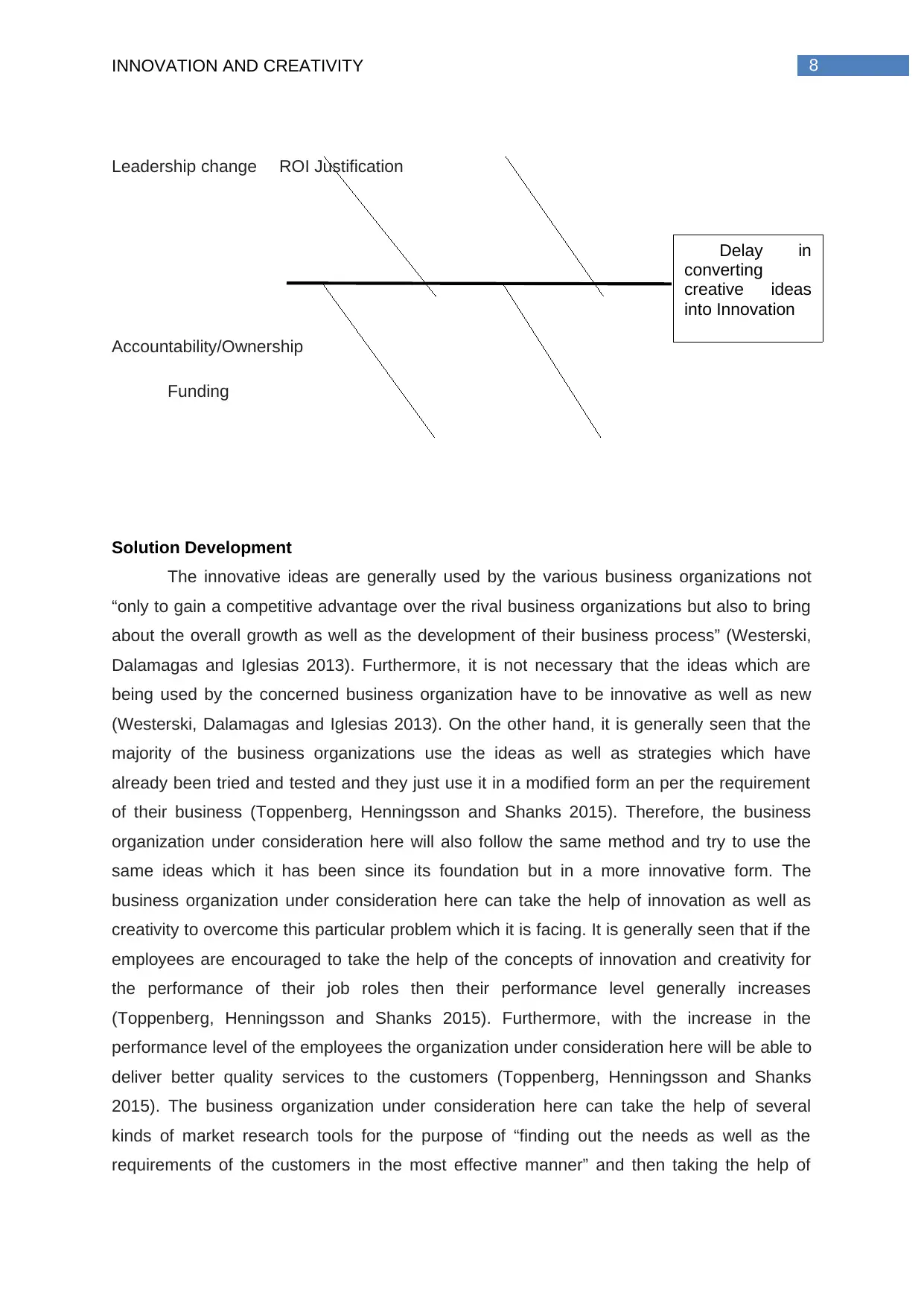
8INNOVATION AND CREATIVITY
Leadership change ROI Justification
Accountability/Ownership
Funding
Solution Development
The innovative ideas are generally used by the various business organizations not
“only to gain a competitive advantage over the rival business organizations but also to bring
about the overall growth as well as the development of their business process” (Westerski,
Dalamagas and Iglesias 2013). Furthermore, it is not necessary that the ideas which are
being used by the concerned business organization have to be innovative as well as new
(Westerski, Dalamagas and Iglesias 2013). On the other hand, it is generally seen that the
majority of the business organizations use the ideas as well as strategies which have
already been tried and tested and they just use it in a modified form an per the requirement
of their business (Toppenberg, Henningsson and Shanks 2015). Therefore, the business
organization under consideration here will also follow the same method and try to use the
same ideas which it has been since its foundation but in a more innovative form. The
business organization under consideration here can take the help of innovation as well as
creativity to overcome this particular problem which it is facing. It is generally seen that if the
employees are encouraged to take the help of the concepts of innovation and creativity for
the performance of their job roles then their performance level generally increases
(Toppenberg, Henningsson and Shanks 2015). Furthermore, with the increase in the
performance level of the employees the organization under consideration here will be able to
deliver better quality services to the customers (Toppenberg, Henningsson and Shanks
2015). The business organization under consideration here can take the help of several
kinds of market research tools for the purpose of “finding out the needs as well as the
requirements of the customers in the most effective manner” and then taking the help of
Delay in
converting
creative ideas
into Innovation
Leadership change ROI Justification
Accountability/Ownership
Funding
Solution Development
The innovative ideas are generally used by the various business organizations not
“only to gain a competitive advantage over the rival business organizations but also to bring
about the overall growth as well as the development of their business process” (Westerski,
Dalamagas and Iglesias 2013). Furthermore, it is not necessary that the ideas which are
being used by the concerned business organization have to be innovative as well as new
(Westerski, Dalamagas and Iglesias 2013). On the other hand, it is generally seen that the
majority of the business organizations use the ideas as well as strategies which have
already been tried and tested and they just use it in a modified form an per the requirement
of their business (Toppenberg, Henningsson and Shanks 2015). Therefore, the business
organization under consideration here will also follow the same method and try to use the
same ideas which it has been since its foundation but in a more innovative form. The
business organization under consideration here can take the help of innovation as well as
creativity to overcome this particular problem which it is facing. It is generally seen that if the
employees are encouraged to take the help of the concepts of innovation and creativity for
the performance of their job roles then their performance level generally increases
(Toppenberg, Henningsson and Shanks 2015). Furthermore, with the increase in the
performance level of the employees the organization under consideration here will be able to
deliver better quality services to the customers (Toppenberg, Henningsson and Shanks
2015). The business organization under consideration here can take the help of several
kinds of market research tools for the purpose of “finding out the needs as well as the
requirements of the customers in the most effective manner” and then taking the help of
Delay in
converting
creative ideas
into Innovation
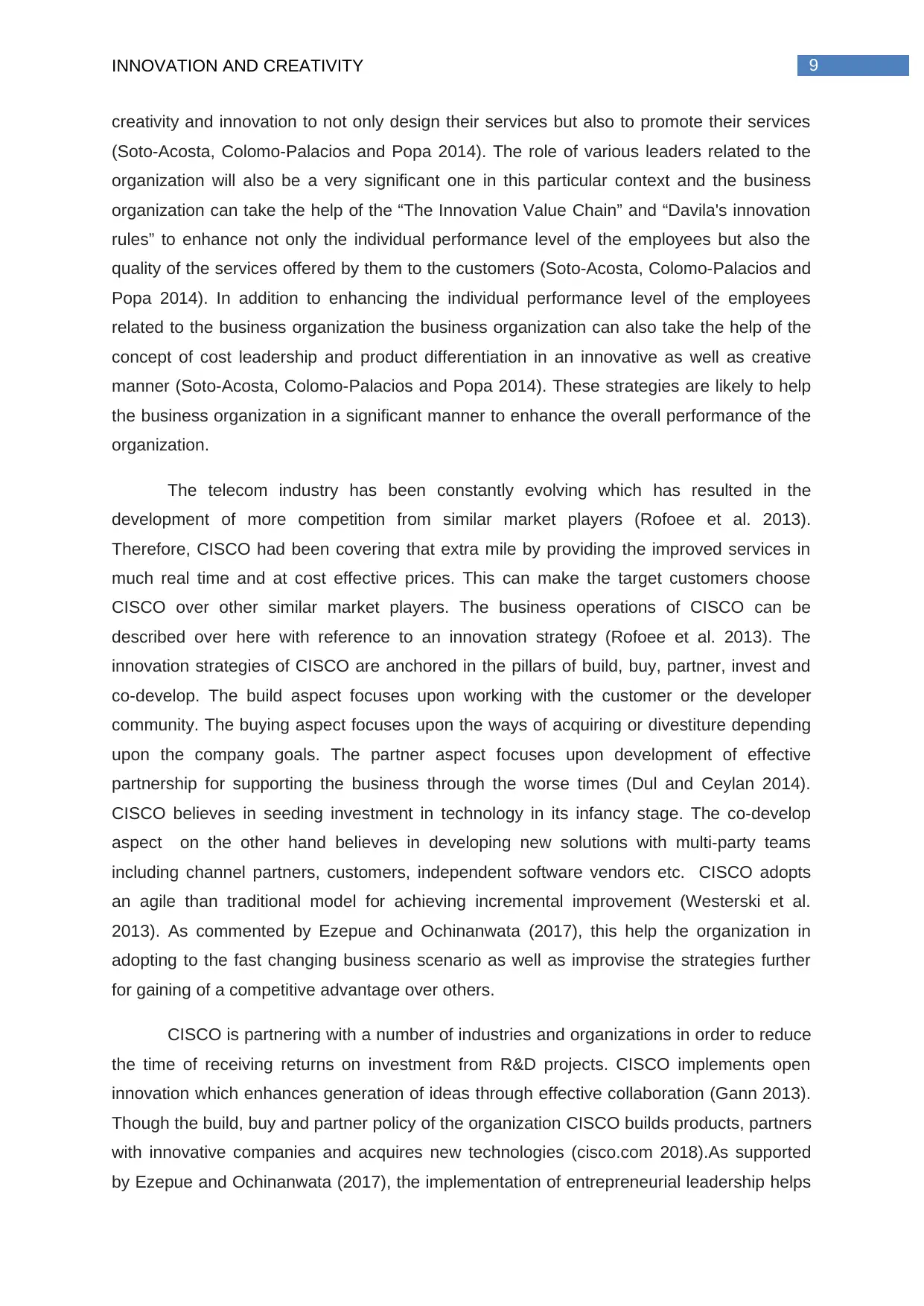
9INNOVATION AND CREATIVITY
creativity and innovation to not only design their services but also to promote their services
(Soto-Acosta, Colomo-Palacios and Popa 2014). The role of various leaders related to the
organization will also be a very significant one in this particular context and the business
organization can take the help of the “The Innovation Value Chain” and “Davila's innovation
rules” to enhance not only the individual performance level of the employees but also the
quality of the services offered by them to the customers (Soto-Acosta, Colomo-Palacios and
Popa 2014). In addition to enhancing the individual performance level of the employees
related to the business organization the business organization can also take the help of the
concept of cost leadership and product differentiation in an innovative as well as creative
manner (Soto-Acosta, Colomo-Palacios and Popa 2014). These strategies are likely to help
the business organization in a significant manner to enhance the overall performance of the
organization.
The telecom industry has been constantly evolving which has resulted in the
development of more competition from similar market players (Rofoee et al. 2013).
Therefore, CISCO had been covering that extra mile by providing the improved services in
much real time and at cost effective prices. This can make the target customers choose
CISCO over other similar market players. The business operations of CISCO can be
described over here with reference to an innovation strategy (Rofoee et al. 2013). The
innovation strategies of CISCO are anchored in the pillars of build, buy, partner, invest and
co-develop. The build aspect focuses upon working with the customer or the developer
community. The buying aspect focuses upon the ways of acquiring or divestiture depending
upon the company goals. The partner aspect focuses upon development of effective
partnership for supporting the business through the worse times (Dul and Ceylan 2014).
CISCO believes in seeding investment in technology in its infancy stage. The co-develop
aspect on the other hand believes in developing new solutions with multi-party teams
including channel partners, customers, independent software vendors etc. CISCO adopts
an agile than traditional model for achieving incremental improvement (Westerski et al.
2013). As commented by Ezepue and Ochinanwata (2017), this help the organization in
adopting to the fast changing business scenario as well as improvise the strategies further
for gaining of a competitive advantage over others.
CISCO is partnering with a number of industries and organizations in order to reduce
the time of receiving returns on investment from R&D projects. CISCO implements open
innovation which enhances generation of ideas through effective collaboration (Gann 2013).
Though the build, buy and partner policy of the organization CISCO builds products, partners
with innovative companies and acquires new technologies (cisco.com 2018).As supported
by Ezepue and Ochinanwata (2017), the implementation of entrepreneurial leadership helps
creativity and innovation to not only design their services but also to promote their services
(Soto-Acosta, Colomo-Palacios and Popa 2014). The role of various leaders related to the
organization will also be a very significant one in this particular context and the business
organization can take the help of the “The Innovation Value Chain” and “Davila's innovation
rules” to enhance not only the individual performance level of the employees but also the
quality of the services offered by them to the customers (Soto-Acosta, Colomo-Palacios and
Popa 2014). In addition to enhancing the individual performance level of the employees
related to the business organization the business organization can also take the help of the
concept of cost leadership and product differentiation in an innovative as well as creative
manner (Soto-Acosta, Colomo-Palacios and Popa 2014). These strategies are likely to help
the business organization in a significant manner to enhance the overall performance of the
organization.
The telecom industry has been constantly evolving which has resulted in the
development of more competition from similar market players (Rofoee et al. 2013).
Therefore, CISCO had been covering that extra mile by providing the improved services in
much real time and at cost effective prices. This can make the target customers choose
CISCO over other similar market players. The business operations of CISCO can be
described over here with reference to an innovation strategy (Rofoee et al. 2013). The
innovation strategies of CISCO are anchored in the pillars of build, buy, partner, invest and
co-develop. The build aspect focuses upon working with the customer or the developer
community. The buying aspect focuses upon the ways of acquiring or divestiture depending
upon the company goals. The partner aspect focuses upon development of effective
partnership for supporting the business through the worse times (Dul and Ceylan 2014).
CISCO believes in seeding investment in technology in its infancy stage. The co-develop
aspect on the other hand believes in developing new solutions with multi-party teams
including channel partners, customers, independent software vendors etc. CISCO adopts
an agile than traditional model for achieving incremental improvement (Westerski et al.
2013). As commented by Ezepue and Ochinanwata (2017), this help the organization in
adopting to the fast changing business scenario as well as improvise the strategies further
for gaining of a competitive advantage over others.
CISCO is partnering with a number of industries and organizations in order to reduce
the time of receiving returns on investment from R&D projects. CISCO implements open
innovation which enhances generation of ideas through effective collaboration (Gann 2013).
Though the build, buy and partner policy of the organization CISCO builds products, partners
with innovative companies and acquires new technologies (cisco.com 2018).As supported
by Ezepue and Ochinanwata (2017), the implementation of entrepreneurial leadership helps
Secure Best Marks with AI Grader
Need help grading? Try our AI Grader for instant feedback on your assignments.
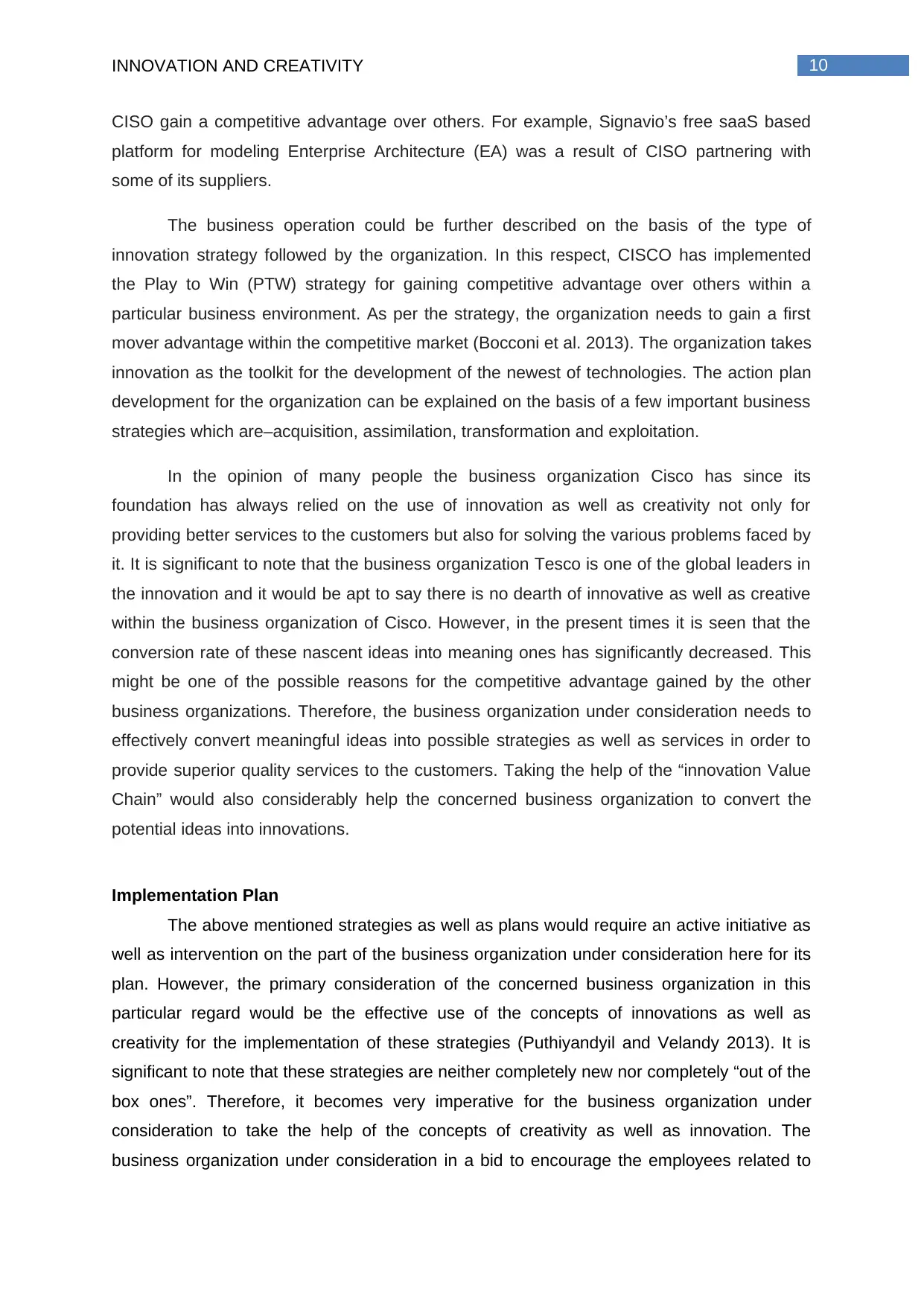
10INNOVATION AND CREATIVITY
CISO gain a competitive advantage over others. For example, Signavio’s free saaS based
platform for modeling Enterprise Architecture (EA) was a result of CISO partnering with
some of its suppliers.
The business operation could be further described on the basis of the type of
innovation strategy followed by the organization. In this respect, CISCO has implemented
the Play to Win (PTW) strategy for gaining competitive advantage over others within a
particular business environment. As per the strategy, the organization needs to gain a first
mover advantage within the competitive market (Bocconi et al. 2013). The organization takes
innovation as the toolkit for the development of the newest of technologies. The action plan
development for the organization can be explained on the basis of a few important business
strategies which are–acquisition, assimilation, transformation and exploitation.
In the opinion of many people the business organization Cisco has since its
foundation has always relied on the use of innovation as well as creativity not only for
providing better services to the customers but also for solving the various problems faced by
it. It is significant to note that the business organization Tesco is one of the global leaders in
the innovation and it would be apt to say there is no dearth of innovative as well as creative
within the business organization of Cisco. However, in the present times it is seen that the
conversion rate of these nascent ideas into meaning ones has significantly decreased. This
might be one of the possible reasons for the competitive advantage gained by the other
business organizations. Therefore, the business organization under consideration needs to
effectively convert meaningful ideas into possible strategies as well as services in order to
provide superior quality services to the customers. Taking the help of the “innovation Value
Chain” would also considerably help the concerned business organization to convert the
potential ideas into innovations.
Implementation Plan
The above mentioned strategies as well as plans would require an active initiative as
well as intervention on the part of the business organization under consideration here for its
plan. However, the primary consideration of the concerned business organization in this
particular regard would be the effective use of the concepts of innovations as well as
creativity for the implementation of these strategies (Puthiyandyil and Velandy 2013). It is
significant to note that these strategies are neither completely new nor completely “out of the
box ones”. Therefore, it becomes very imperative for the business organization under
consideration to take the help of the concepts of creativity as well as innovation. The
business organization under consideration in a bid to encourage the employees related to
CISO gain a competitive advantage over others. For example, Signavio’s free saaS based
platform for modeling Enterprise Architecture (EA) was a result of CISO partnering with
some of its suppliers.
The business operation could be further described on the basis of the type of
innovation strategy followed by the organization. In this respect, CISCO has implemented
the Play to Win (PTW) strategy for gaining competitive advantage over others within a
particular business environment. As per the strategy, the organization needs to gain a first
mover advantage within the competitive market (Bocconi et al. 2013). The organization takes
innovation as the toolkit for the development of the newest of technologies. The action plan
development for the organization can be explained on the basis of a few important business
strategies which are–acquisition, assimilation, transformation and exploitation.
In the opinion of many people the business organization Cisco has since its
foundation has always relied on the use of innovation as well as creativity not only for
providing better services to the customers but also for solving the various problems faced by
it. It is significant to note that the business organization Tesco is one of the global leaders in
the innovation and it would be apt to say there is no dearth of innovative as well as creative
within the business organization of Cisco. However, in the present times it is seen that the
conversion rate of these nascent ideas into meaning ones has significantly decreased. This
might be one of the possible reasons for the competitive advantage gained by the other
business organizations. Therefore, the business organization under consideration needs to
effectively convert meaningful ideas into possible strategies as well as services in order to
provide superior quality services to the customers. Taking the help of the “innovation Value
Chain” would also considerably help the concerned business organization to convert the
potential ideas into innovations.
Implementation Plan
The above mentioned strategies as well as plans would require an active initiative as
well as intervention on the part of the business organization under consideration here for its
plan. However, the primary consideration of the concerned business organization in this
particular regard would be the effective use of the concepts of innovations as well as
creativity for the implementation of these strategies (Puthiyandyil and Velandy 2013). It is
significant to note that these strategies are neither completely new nor completely “out of the
box ones”. Therefore, it becomes very imperative for the business organization under
consideration to take the help of the concepts of creativity as well as innovation. The
business organization under consideration in a bid to encourage the employees related to
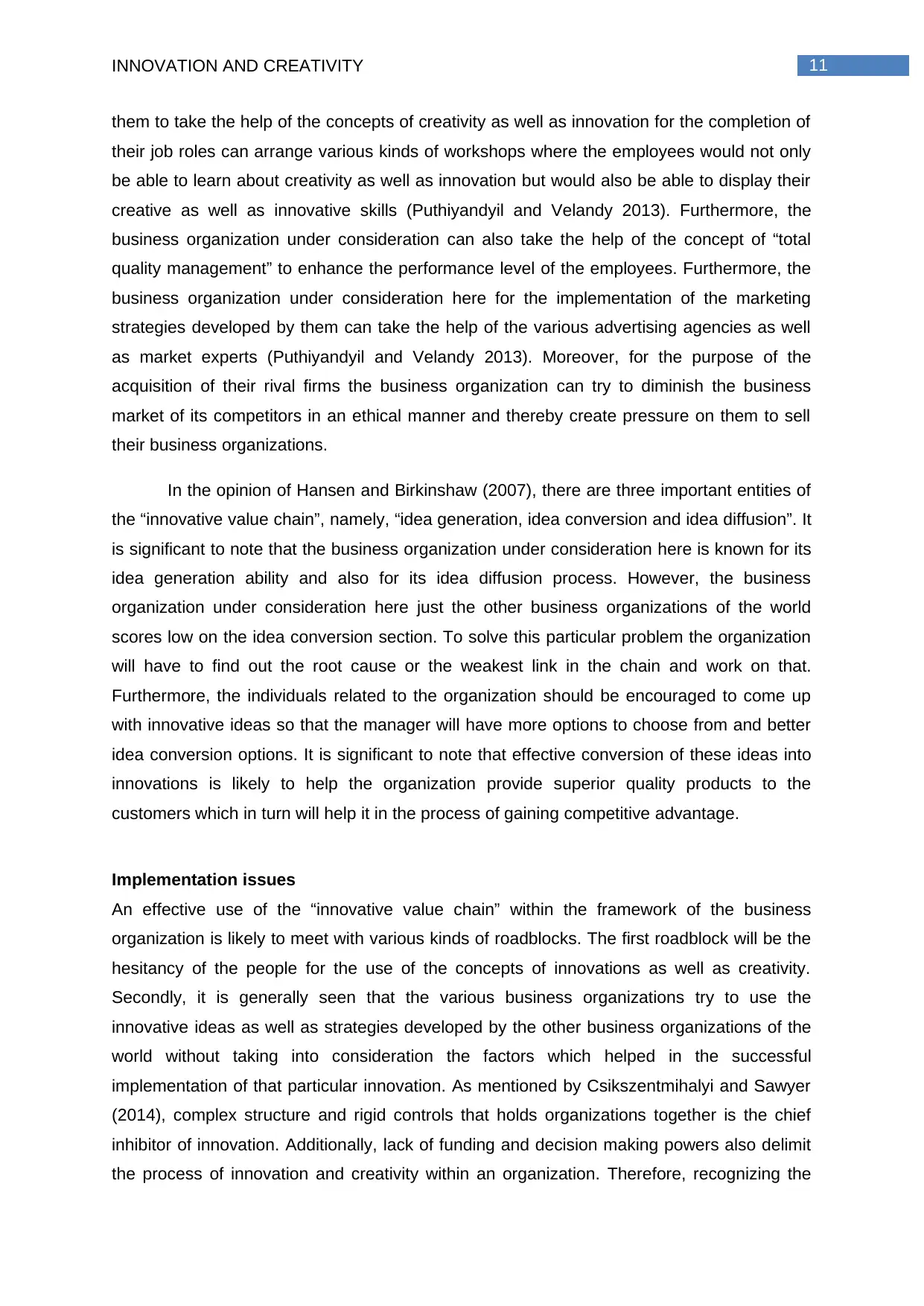
11INNOVATION AND CREATIVITY
them to take the help of the concepts of creativity as well as innovation for the completion of
their job roles can arrange various kinds of workshops where the employees would not only
be able to learn about creativity as well as innovation but would also be able to display their
creative as well as innovative skills (Puthiyandyil and Velandy 2013). Furthermore, the
business organization under consideration can also take the help of the concept of “total
quality management” to enhance the performance level of the employees. Furthermore, the
business organization under consideration here for the implementation of the marketing
strategies developed by them can take the help of the various advertising agencies as well
as market experts (Puthiyandyil and Velandy 2013). Moreover, for the purpose of the
acquisition of their rival firms the business organization can try to diminish the business
market of its competitors in an ethical manner and thereby create pressure on them to sell
their business organizations.
In the opinion of Hansen and Birkinshaw (2007), there are three important entities of
the “innovative value chain”, namely, “idea generation, idea conversion and idea diffusion”. It
is significant to note that the business organization under consideration here is known for its
idea generation ability and also for its idea diffusion process. However, the business
organization under consideration here just the other business organizations of the world
scores low on the idea conversion section. To solve this particular problem the organization
will have to find out the root cause or the weakest link in the chain and work on that.
Furthermore, the individuals related to the organization should be encouraged to come up
with innovative ideas so that the manager will have more options to choose from and better
idea conversion options. It is significant to note that effective conversion of these ideas into
innovations is likely to help the organization provide superior quality products to the
customers which in turn will help it in the process of gaining competitive advantage.
Implementation issues
An effective use of the “innovative value chain” within the framework of the business
organization is likely to meet with various kinds of roadblocks. The first roadblock will be the
hesitancy of the people for the use of the concepts of innovations as well as creativity.
Secondly, it is generally seen that the various business organizations try to use the
innovative ideas as well as strategies developed by the other business organizations of the
world without taking into consideration the factors which helped in the successful
implementation of that particular innovation. As mentioned by Csikszentmihalyi and Sawyer
(2014), complex structure and rigid controls that holds organizations together is the chief
inhibitor of innovation. Additionally, lack of funding and decision making powers also delimit
the process of innovation and creativity within an organization. Therefore, recognizing the
them to take the help of the concepts of creativity as well as innovation for the completion of
their job roles can arrange various kinds of workshops where the employees would not only
be able to learn about creativity as well as innovation but would also be able to display their
creative as well as innovative skills (Puthiyandyil and Velandy 2013). Furthermore, the
business organization under consideration can also take the help of the concept of “total
quality management” to enhance the performance level of the employees. Furthermore, the
business organization under consideration here for the implementation of the marketing
strategies developed by them can take the help of the various advertising agencies as well
as market experts (Puthiyandyil and Velandy 2013). Moreover, for the purpose of the
acquisition of their rival firms the business organization can try to diminish the business
market of its competitors in an ethical manner and thereby create pressure on them to sell
their business organizations.
In the opinion of Hansen and Birkinshaw (2007), there are three important entities of
the “innovative value chain”, namely, “idea generation, idea conversion and idea diffusion”. It
is significant to note that the business organization under consideration here is known for its
idea generation ability and also for its idea diffusion process. However, the business
organization under consideration here just the other business organizations of the world
scores low on the idea conversion section. To solve this particular problem the organization
will have to find out the root cause or the weakest link in the chain and work on that.
Furthermore, the individuals related to the organization should be encouraged to come up
with innovative ideas so that the manager will have more options to choose from and better
idea conversion options. It is significant to note that effective conversion of these ideas into
innovations is likely to help the organization provide superior quality products to the
customers which in turn will help it in the process of gaining competitive advantage.
Implementation issues
An effective use of the “innovative value chain” within the framework of the business
organization is likely to meet with various kinds of roadblocks. The first roadblock will be the
hesitancy of the people for the use of the concepts of innovations as well as creativity.
Secondly, it is generally seen that the various business organizations try to use the
innovative ideas as well as strategies developed by the other business organizations of the
world without taking into consideration the factors which helped in the successful
implementation of that particular innovation. As mentioned by Csikszentmihalyi and Sawyer
(2014), complex structure and rigid controls that holds organizations together is the chief
inhibitor of innovation. Additionally, lack of funding and decision making powers also delimit
the process of innovation and creativity within an organization. Therefore, recognizing the
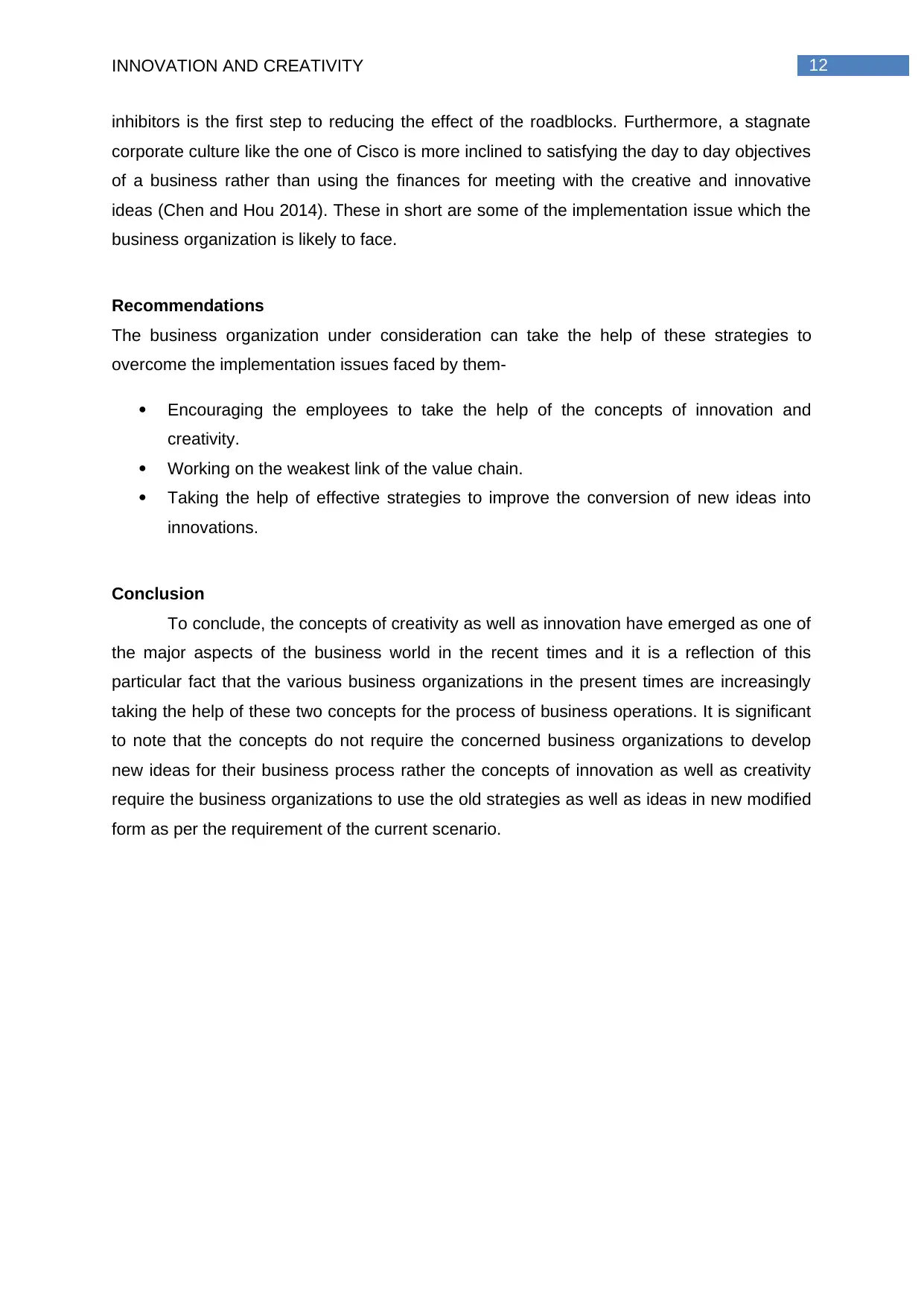
12INNOVATION AND CREATIVITY
inhibitors is the first step to reducing the effect of the roadblocks. Furthermore, a stagnate
corporate culture like the one of Cisco is more inclined to satisfying the day to day objectives
of a business rather than using the finances for meeting with the creative and innovative
ideas (Chen and Hou 2014). These in short are some of the implementation issue which the
business organization is likely to face.
Recommendations
The business organization under consideration can take the help of these strategies to
overcome the implementation issues faced by them-
Encouraging the employees to take the help of the concepts of innovation and
creativity.
Working on the weakest link of the value chain.
Taking the help of effective strategies to improve the conversion of new ideas into
innovations.
Conclusion
To conclude, the concepts of creativity as well as innovation have emerged as one of
the major aspects of the business world in the recent times and it is a reflection of this
particular fact that the various business organizations in the present times are increasingly
taking the help of these two concepts for the process of business operations. It is significant
to note that the concepts do not require the concerned business organizations to develop
new ideas for their business process rather the concepts of innovation as well as creativity
require the business organizations to use the old strategies as well as ideas in new modified
form as per the requirement of the current scenario.
inhibitors is the first step to reducing the effect of the roadblocks. Furthermore, a stagnate
corporate culture like the one of Cisco is more inclined to satisfying the day to day objectives
of a business rather than using the finances for meeting with the creative and innovative
ideas (Chen and Hou 2014). These in short are some of the implementation issue which the
business organization is likely to face.
Recommendations
The business organization under consideration can take the help of these strategies to
overcome the implementation issues faced by them-
Encouraging the employees to take the help of the concepts of innovation and
creativity.
Working on the weakest link of the value chain.
Taking the help of effective strategies to improve the conversion of new ideas into
innovations.
Conclusion
To conclude, the concepts of creativity as well as innovation have emerged as one of
the major aspects of the business world in the recent times and it is a reflection of this
particular fact that the various business organizations in the present times are increasingly
taking the help of these two concepts for the process of business operations. It is significant
to note that the concepts do not require the concerned business organizations to develop
new ideas for their business process rather the concepts of innovation as well as creativity
require the business organizations to use the old strategies as well as ideas in new modified
form as per the requirement of the current scenario.
Paraphrase This Document
Need a fresh take? Get an instant paraphrase of this document with our AI Paraphraser
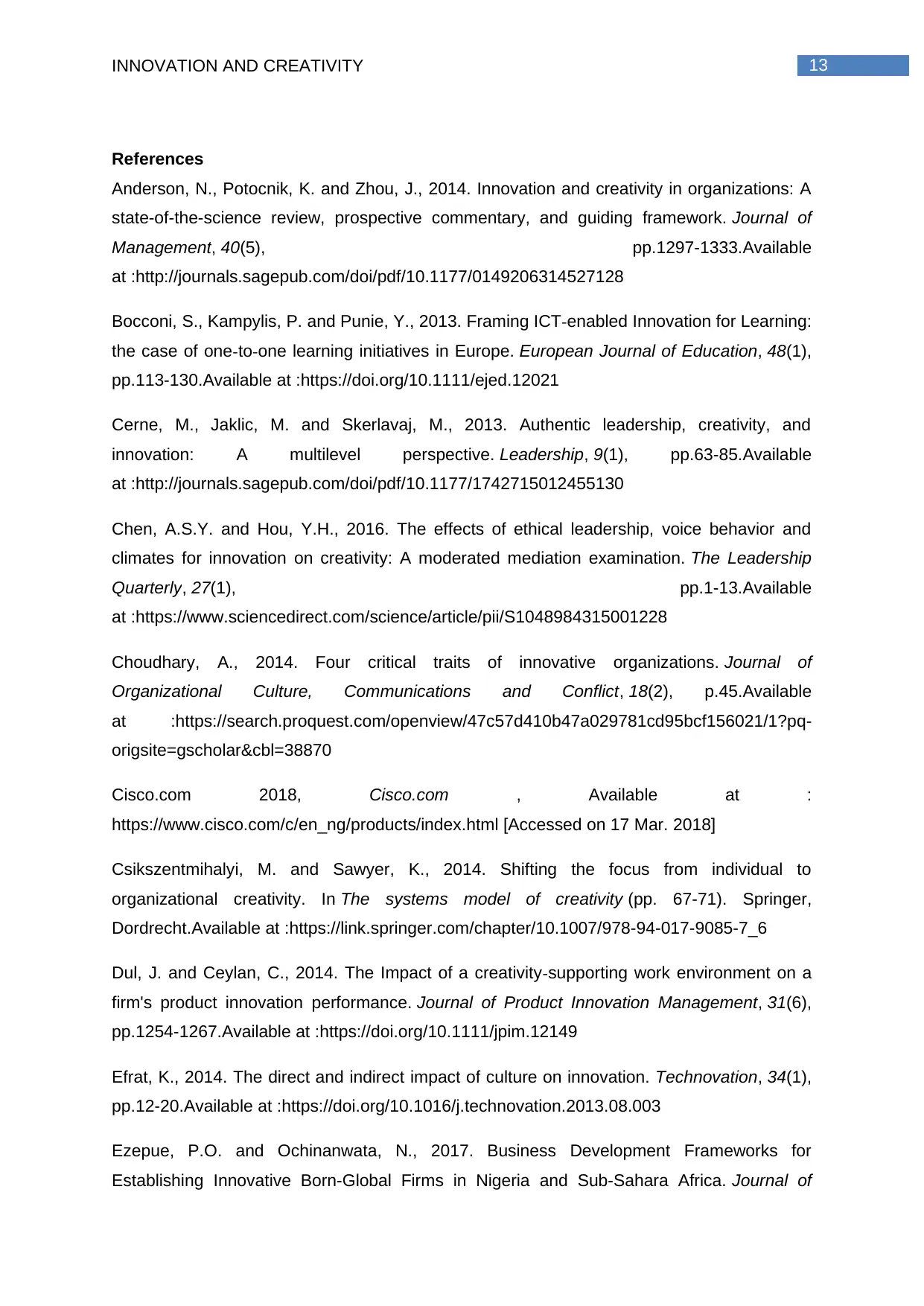
13INNOVATION AND CREATIVITY
References
Anderson, N., Potocnik, K. and Zhou, J., 2014. Innovation and creativity in organizations: A
state-of-the-science review, prospective commentary, and guiding framework. Journal of
Management, 40(5), pp.1297-1333.Available
at :http://journals.sagepub.com/doi/pdf/10.1177/0149206314527128
Bocconi, S., Kampylis, P. and Punie, Y., 2013. Framing ICT‐enabled Innovation for Learning:
the case of one‐to‐one learning initiatives in Europe. European Journal of Education, 48(1),
pp.113-130.Available at :https://doi.org/10.1111/ejed.12021
Cerne, M., Jaklic, M. and Skerlavaj, M., 2013. Authentic leadership, creativity, and
innovation: A multilevel perspective. Leadership, 9(1), pp.63-85.Available
at :http://journals.sagepub.com/doi/pdf/10.1177/1742715012455130
Chen, A.S.Y. and Hou, Y.H., 2016. The effects of ethical leadership, voice behavior and
climates for innovation on creativity: A moderated mediation examination. The Leadership
Quarterly, 27(1), pp.1-13.Available
at :https://www.sciencedirect.com/science/article/pii/S1048984315001228
Choudhary, A., 2014. Four critical traits of innovative organizations. Journal of
Organizational Culture, Communications and Conflict, 18(2), p.45.Available
at :https://search.proquest.com/openview/47c57d410b47a029781cd95bcf156021/1?pq-
origsite=gscholar&cbl=38870
Cisco.com 2018, Cisco.com , Available at :
https://www.cisco.com/c/en_ng/products/index.html [Accessed on 17 Mar. 2018]
Csikszentmihalyi, M. and Sawyer, K., 2014. Shifting the focus from individual to
organizational creativity. In The systems model of creativity (pp. 67-71). Springer,
Dordrecht.Available at :https://link.springer.com/chapter/10.1007/978-94-017-9085-7_6
Dul, J. and Ceylan, C., 2014. The Impact of a creativity‐supporting work environment on a
firm's product innovation performance. Journal of Product Innovation Management, 31(6),
pp.1254-1267.Available at :https://doi.org/10.1111/jpim.12149
Efrat, K., 2014. The direct and indirect impact of culture on innovation. Technovation, 34(1),
pp.12-20.Available at :https://doi.org/10.1016/j.technovation.2013.08.003
Ezepue, P.O. and Ochinanwata, N., 2017. Business Development Frameworks for
Establishing Innovative Born-Global Firms in Nigeria and Sub-Sahara Africa. Journal of
References
Anderson, N., Potocnik, K. and Zhou, J., 2014. Innovation and creativity in organizations: A
state-of-the-science review, prospective commentary, and guiding framework. Journal of
Management, 40(5), pp.1297-1333.Available
at :http://journals.sagepub.com/doi/pdf/10.1177/0149206314527128
Bocconi, S., Kampylis, P. and Punie, Y., 2013. Framing ICT‐enabled Innovation for Learning:
the case of one‐to‐one learning initiatives in Europe. European Journal of Education, 48(1),
pp.113-130.Available at :https://doi.org/10.1111/ejed.12021
Cerne, M., Jaklic, M. and Skerlavaj, M., 2013. Authentic leadership, creativity, and
innovation: A multilevel perspective. Leadership, 9(1), pp.63-85.Available
at :http://journals.sagepub.com/doi/pdf/10.1177/1742715012455130
Chen, A.S.Y. and Hou, Y.H., 2016. The effects of ethical leadership, voice behavior and
climates for innovation on creativity: A moderated mediation examination. The Leadership
Quarterly, 27(1), pp.1-13.Available
at :https://www.sciencedirect.com/science/article/pii/S1048984315001228
Choudhary, A., 2014. Four critical traits of innovative organizations. Journal of
Organizational Culture, Communications and Conflict, 18(2), p.45.Available
at :https://search.proquest.com/openview/47c57d410b47a029781cd95bcf156021/1?pq-
origsite=gscholar&cbl=38870
Cisco.com 2018, Cisco.com , Available at :
https://www.cisco.com/c/en_ng/products/index.html [Accessed on 17 Mar. 2018]
Csikszentmihalyi, M. and Sawyer, K., 2014. Shifting the focus from individual to
organizational creativity. In The systems model of creativity (pp. 67-71). Springer,
Dordrecht.Available at :https://link.springer.com/chapter/10.1007/978-94-017-9085-7_6
Dul, J. and Ceylan, C., 2014. The Impact of a creativity‐supporting work environment on a
firm's product innovation performance. Journal of Product Innovation Management, 31(6),
pp.1254-1267.Available at :https://doi.org/10.1111/jpim.12149
Efrat, K., 2014. The direct and indirect impact of culture on innovation. Technovation, 34(1),
pp.12-20.Available at :https://doi.org/10.1016/j.technovation.2013.08.003
Ezepue, P.O. and Ochinanwata, N., 2017. Business Development Frameworks for
Establishing Innovative Born-Global Firms in Nigeria and Sub-Sahara Africa. Journal of
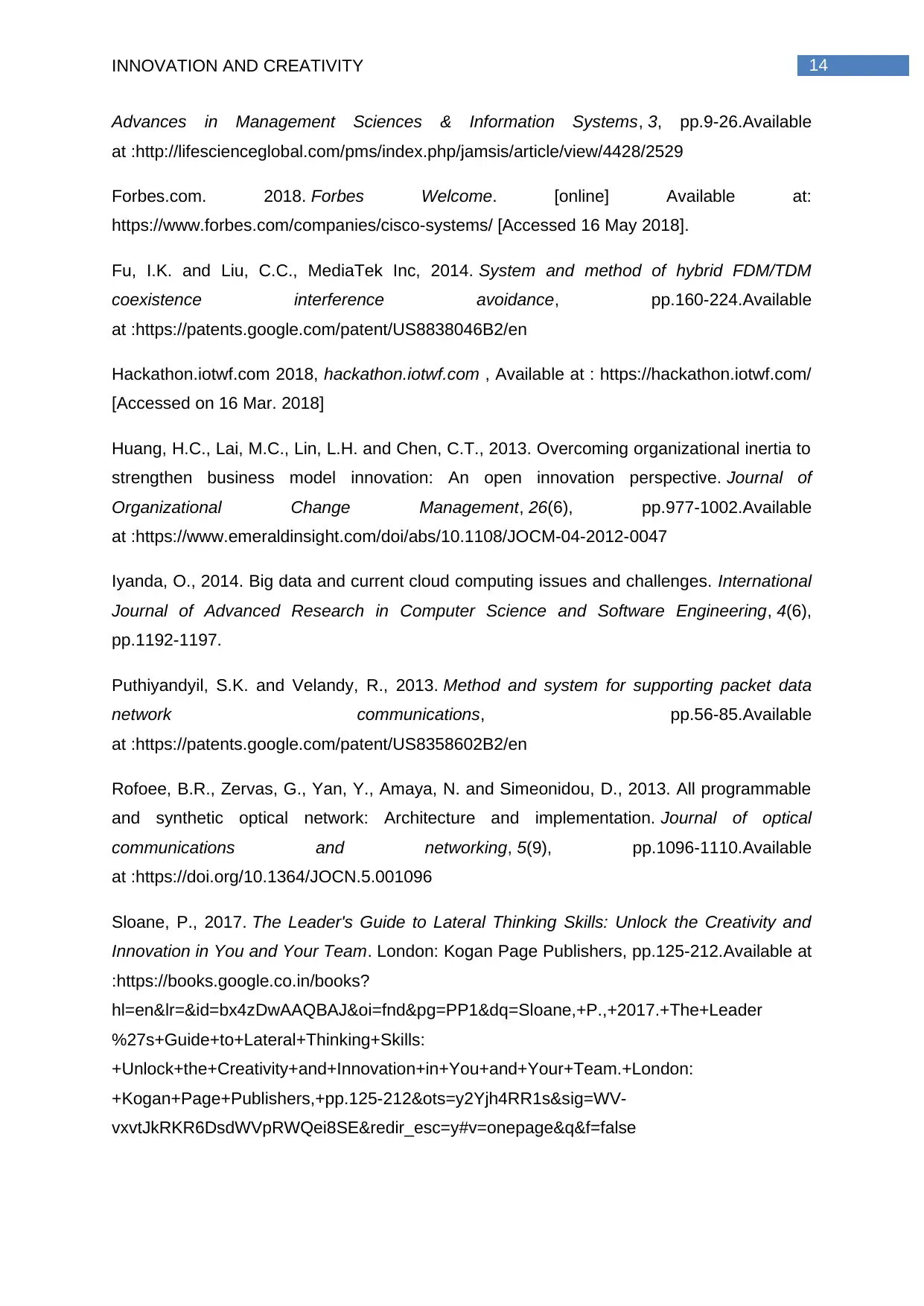
14INNOVATION AND CREATIVITY
Advances in Management Sciences & Information Systems, 3, pp.9-26.Available
at :http://lifescienceglobal.com/pms/index.php/jamsis/article/view/4428/2529
Forbes.com. 2018. Forbes Welcome. [online] Available at:
https://www.forbes.com/companies/cisco-systems/ [Accessed 16 May 2018].
Fu, I.K. and Liu, C.C., MediaTek Inc, 2014. System and method of hybrid FDM/TDM
coexistence interference avoidance, pp.160-224.Available
at :https://patents.google.com/patent/US8838046B2/en
Hackathon.iotwf.com 2018, hackathon.iotwf.com , Available at : https://hackathon.iotwf.com/
[Accessed on 16 Mar. 2018]
Huang, H.C., Lai, M.C., Lin, L.H. and Chen, C.T., 2013. Overcoming organizational inertia to
strengthen business model innovation: An open innovation perspective. Journal of
Organizational Change Management, 26(6), pp.977-1002.Available
at :https://www.emeraldinsight.com/doi/abs/10.1108/JOCM-04-2012-0047
Iyanda, O., 2014. Big data and current cloud computing issues and challenges. International
Journal of Advanced Research in Computer Science and Software Engineering, 4(6),
pp.1192-1197.
Puthiyandyil, S.K. and Velandy, R., 2013. Method and system for supporting packet data
network communications, pp.56-85.Available
at :https://patents.google.com/patent/US8358602B2/en
Rofoee, B.R., Zervas, G., Yan, Y., Amaya, N. and Simeonidou, D., 2013. All programmable
and synthetic optical network: Architecture and implementation. Journal of optical
communications and networking, 5(9), pp.1096-1110.Available
at :https://doi.org/10.1364/JOCN.5.001096
Sloane, P., 2017. The Leader's Guide to Lateral Thinking Skills: Unlock the Creativity and
Innovation in You and Your Team. London: Kogan Page Publishers, pp.125-212.Available at
:https://books.google.co.in/books?
hl=en&lr=&id=bx4zDwAAQBAJ&oi=fnd&pg=PP1&dq=Sloane,+P.,+2017.+The+Leader
%27s+Guide+to+Lateral+Thinking+Skills:
+Unlock+the+Creativity+and+Innovation+in+You+and+Your+Team.+London:
+Kogan+Page+Publishers,+pp.125-212&ots=y2Yjh4RR1s&sig=WV-
vxvtJkRKR6DsdWVpRWQei8SE&redir_esc=y#v=onepage&q&f=false
Advances in Management Sciences & Information Systems, 3, pp.9-26.Available
at :http://lifescienceglobal.com/pms/index.php/jamsis/article/view/4428/2529
Forbes.com. 2018. Forbes Welcome. [online] Available at:
https://www.forbes.com/companies/cisco-systems/ [Accessed 16 May 2018].
Fu, I.K. and Liu, C.C., MediaTek Inc, 2014. System and method of hybrid FDM/TDM
coexistence interference avoidance, pp.160-224.Available
at :https://patents.google.com/patent/US8838046B2/en
Hackathon.iotwf.com 2018, hackathon.iotwf.com , Available at : https://hackathon.iotwf.com/
[Accessed on 16 Mar. 2018]
Huang, H.C., Lai, M.C., Lin, L.H. and Chen, C.T., 2013. Overcoming organizational inertia to
strengthen business model innovation: An open innovation perspective. Journal of
Organizational Change Management, 26(6), pp.977-1002.Available
at :https://www.emeraldinsight.com/doi/abs/10.1108/JOCM-04-2012-0047
Iyanda, O., 2014. Big data and current cloud computing issues and challenges. International
Journal of Advanced Research in Computer Science and Software Engineering, 4(6),
pp.1192-1197.
Puthiyandyil, S.K. and Velandy, R., 2013. Method and system for supporting packet data
network communications, pp.56-85.Available
at :https://patents.google.com/patent/US8358602B2/en
Rofoee, B.R., Zervas, G., Yan, Y., Amaya, N. and Simeonidou, D., 2013. All programmable
and synthetic optical network: Architecture and implementation. Journal of optical
communications and networking, 5(9), pp.1096-1110.Available
at :https://doi.org/10.1364/JOCN.5.001096
Sloane, P., 2017. The Leader's Guide to Lateral Thinking Skills: Unlock the Creativity and
Innovation in You and Your Team. London: Kogan Page Publishers, pp.125-212.Available at
:https://books.google.co.in/books?
hl=en&lr=&id=bx4zDwAAQBAJ&oi=fnd&pg=PP1&dq=Sloane,+P.,+2017.+The+Leader
%27s+Guide+to+Lateral+Thinking+Skills:
+Unlock+the+Creativity+and+Innovation+in+You+and+Your+Team.+London:
+Kogan+Page+Publishers,+pp.125-212&ots=y2Yjh4RR1s&sig=WV-
vxvtJkRKR6DsdWVpRWQei8SE&redir_esc=y#v=onepage&q&f=false
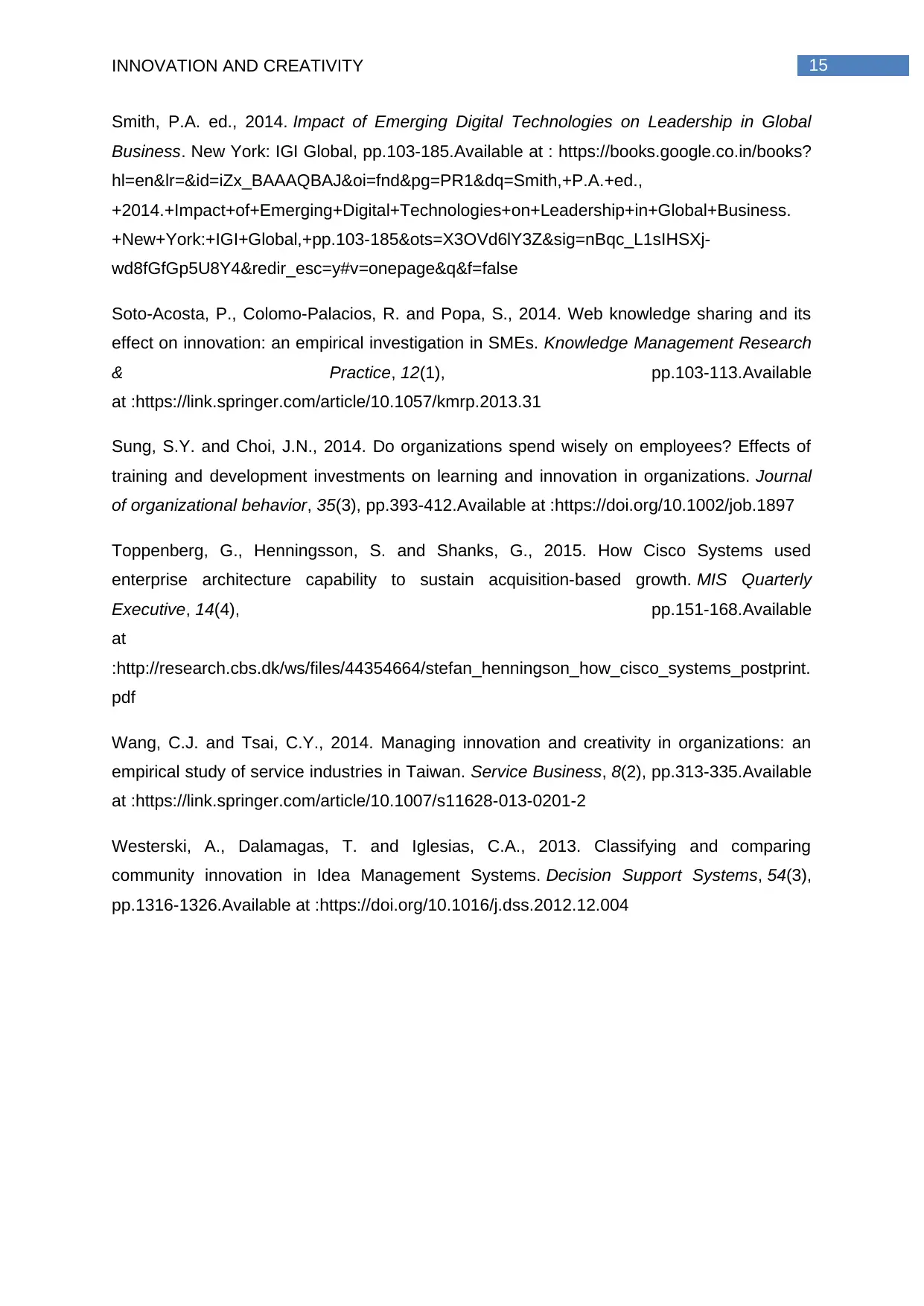
15INNOVATION AND CREATIVITY
Smith, P.A. ed., 2014. Impact of Emerging Digital Technologies on Leadership in Global
Business. New York: IGI Global, pp.103-185.Available at : https://books.google.co.in/books?
hl=en&lr=&id=iZx_BAAAQBAJ&oi=fnd&pg=PR1&dq=Smith,+P.A.+ed.,
+2014.+Impact+of+Emerging+Digital+Technologies+on+Leadership+in+Global+Business.
+New+York:+IGI+Global,+pp.103-185&ots=X3OVd6lY3Z&sig=nBqc_L1sIHSXj-
wd8fGfGp5U8Y4&redir_esc=y#v=onepage&q&f=false
Soto-Acosta, P., Colomo-Palacios, R. and Popa, S., 2014. Web knowledge sharing and its
effect on innovation: an empirical investigation in SMEs. Knowledge Management Research
& Practice, 12(1), pp.103-113.Available
at :https://link.springer.com/article/10.1057/kmrp.2013.31
Sung, S.Y. and Choi, J.N., 2014. Do organizations spend wisely on employees? Effects of
training and development investments on learning and innovation in organizations. Journal
of organizational behavior, 35(3), pp.393-412.Available at :https://doi.org/10.1002/job.1897
Toppenberg, G., Henningsson, S. and Shanks, G., 2015. How Cisco Systems used
enterprise architecture capability to sustain acquisition-based growth. MIS Quarterly
Executive, 14(4), pp.151-168.Available
at
:http://research.cbs.dk/ws/files/44354664/stefan_henningson_how_cisco_systems_postprint.
pdf
Wang, C.J. and Tsai, C.Y., 2014. Managing innovation and creativity in organizations: an
empirical study of service industries in Taiwan. Service Business, 8(2), pp.313-335.Available
at :https://link.springer.com/article/10.1007/s11628-013-0201-2
Westerski, A., Dalamagas, T. and Iglesias, C.A., 2013. Classifying and comparing
community innovation in Idea Management Systems. Decision Support Systems, 54(3),
pp.1316-1326.Available at :https://doi.org/10.1016/j.dss.2012.12.004
Smith, P.A. ed., 2014. Impact of Emerging Digital Technologies on Leadership in Global
Business. New York: IGI Global, pp.103-185.Available at : https://books.google.co.in/books?
hl=en&lr=&id=iZx_BAAAQBAJ&oi=fnd&pg=PR1&dq=Smith,+P.A.+ed.,
+2014.+Impact+of+Emerging+Digital+Technologies+on+Leadership+in+Global+Business.
+New+York:+IGI+Global,+pp.103-185&ots=X3OVd6lY3Z&sig=nBqc_L1sIHSXj-
wd8fGfGp5U8Y4&redir_esc=y#v=onepage&q&f=false
Soto-Acosta, P., Colomo-Palacios, R. and Popa, S., 2014. Web knowledge sharing and its
effect on innovation: an empirical investigation in SMEs. Knowledge Management Research
& Practice, 12(1), pp.103-113.Available
at :https://link.springer.com/article/10.1057/kmrp.2013.31
Sung, S.Y. and Choi, J.N., 2014. Do organizations spend wisely on employees? Effects of
training and development investments on learning and innovation in organizations. Journal
of organizational behavior, 35(3), pp.393-412.Available at :https://doi.org/10.1002/job.1897
Toppenberg, G., Henningsson, S. and Shanks, G., 2015. How Cisco Systems used
enterprise architecture capability to sustain acquisition-based growth. MIS Quarterly
Executive, 14(4), pp.151-168.Available
at
:http://research.cbs.dk/ws/files/44354664/stefan_henningson_how_cisco_systems_postprint.
Wang, C.J. and Tsai, C.Y., 2014. Managing innovation and creativity in organizations: an
empirical study of service industries in Taiwan. Service Business, 8(2), pp.313-335.Available
at :https://link.springer.com/article/10.1007/s11628-013-0201-2
Westerski, A., Dalamagas, T. and Iglesias, C.A., 2013. Classifying and comparing
community innovation in Idea Management Systems. Decision Support Systems, 54(3),
pp.1316-1326.Available at :https://doi.org/10.1016/j.dss.2012.12.004
1 out of 16
Related Documents
Your All-in-One AI-Powered Toolkit for Academic Success.
+13062052269
info@desklib.com
Available 24*7 on WhatsApp / Email
![[object Object]](/_next/static/media/star-bottom.7253800d.svg)
Unlock your academic potential
© 2024 | Zucol Services PVT LTD | All rights reserved.




